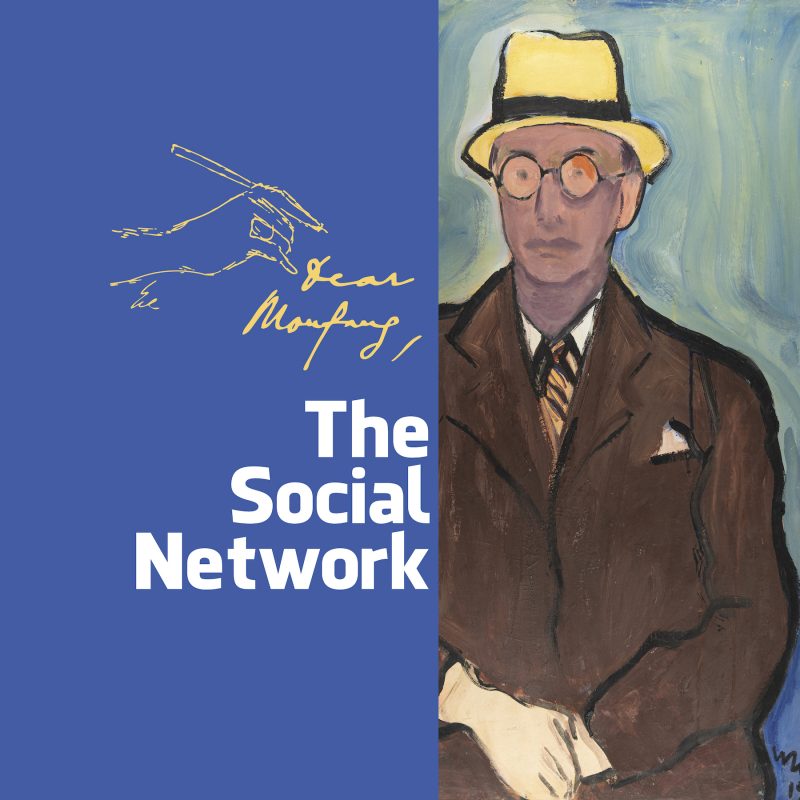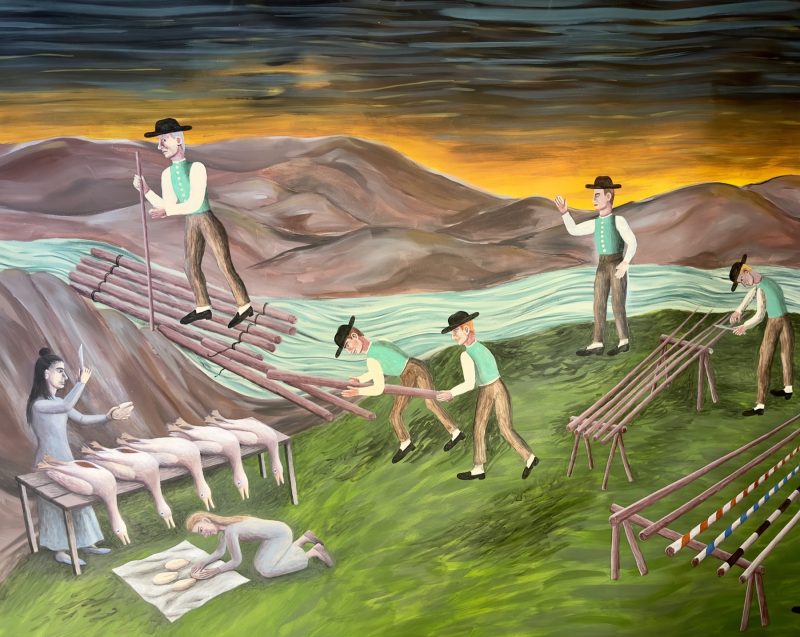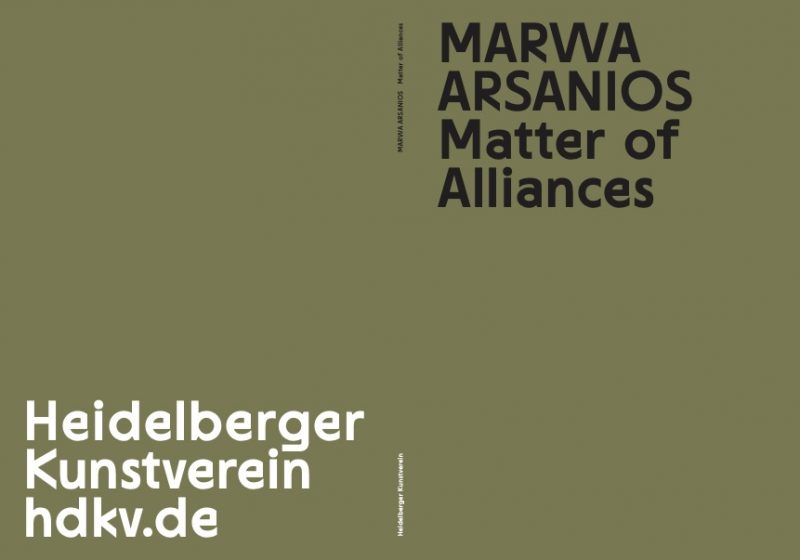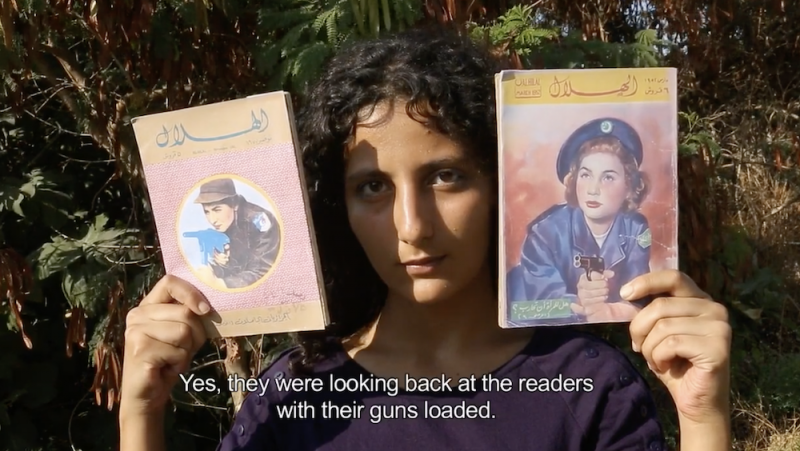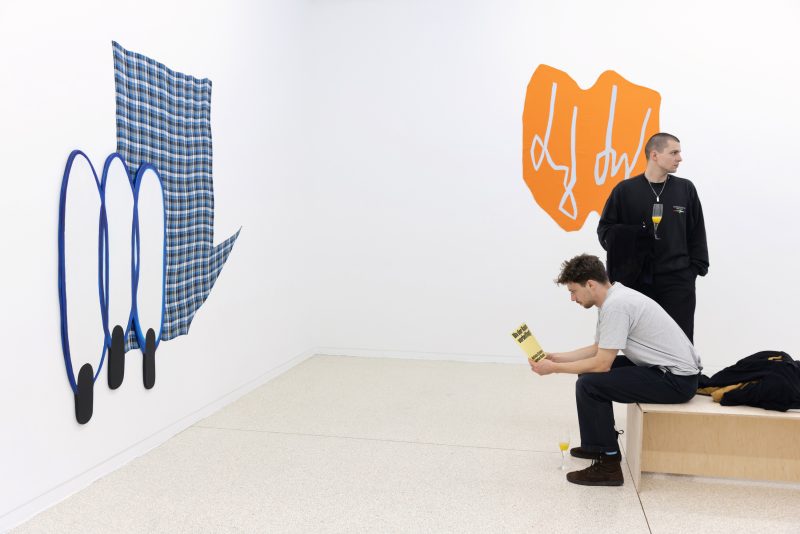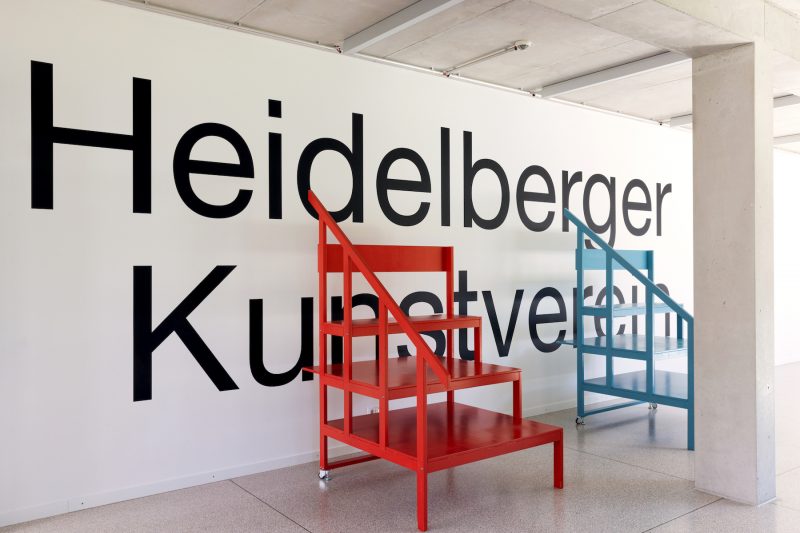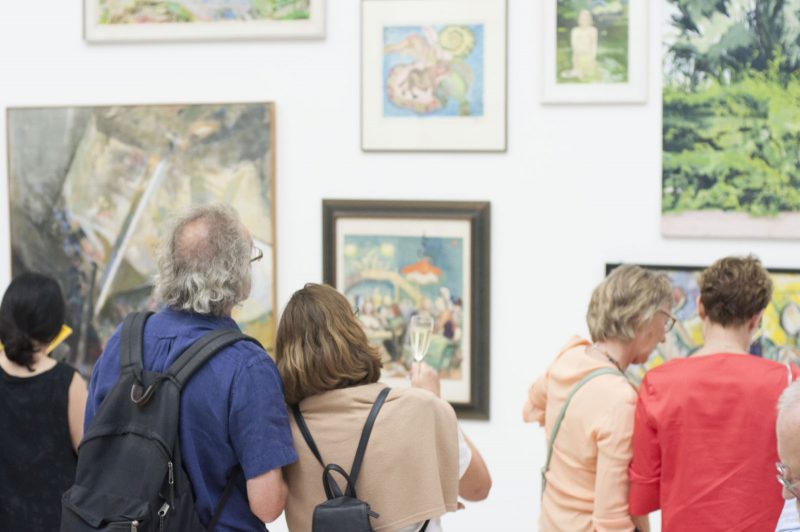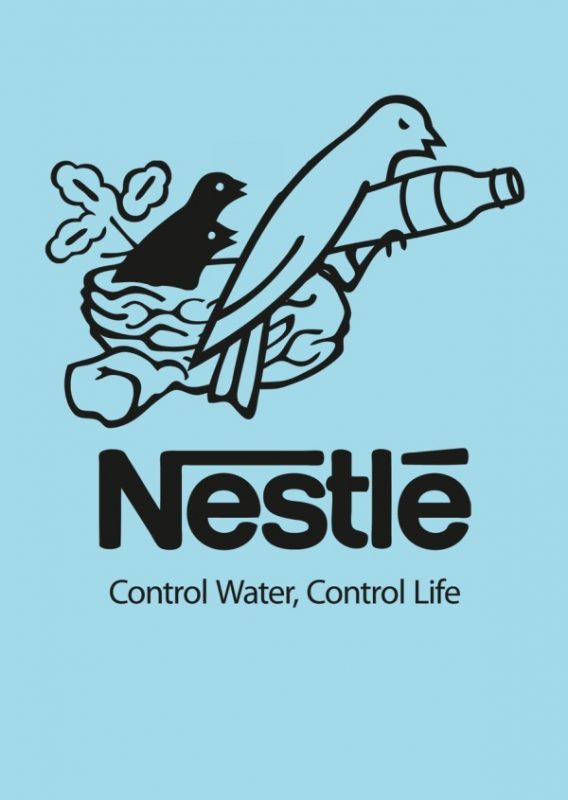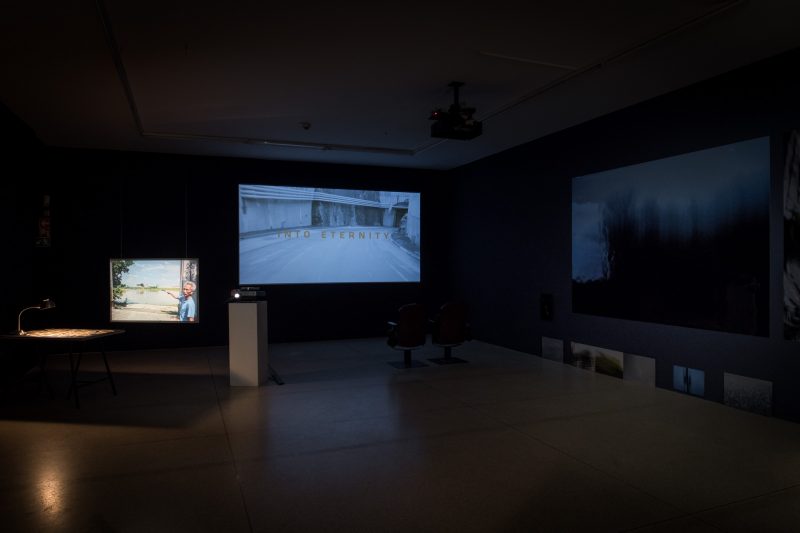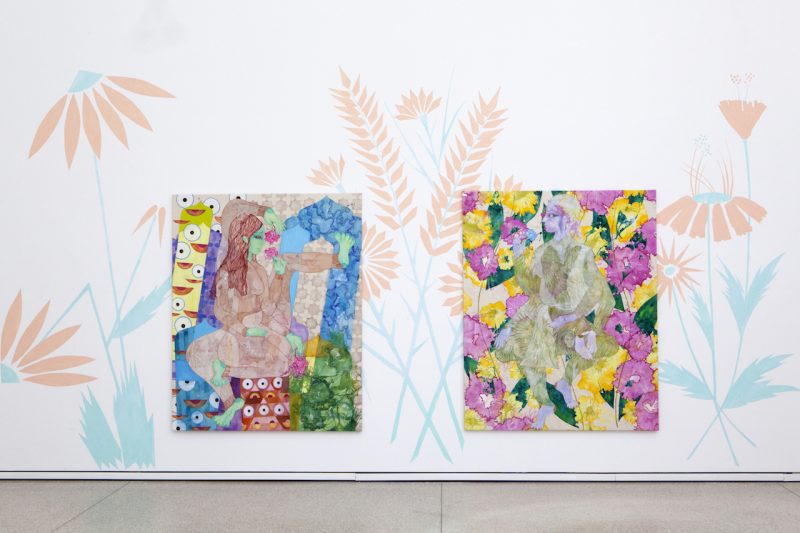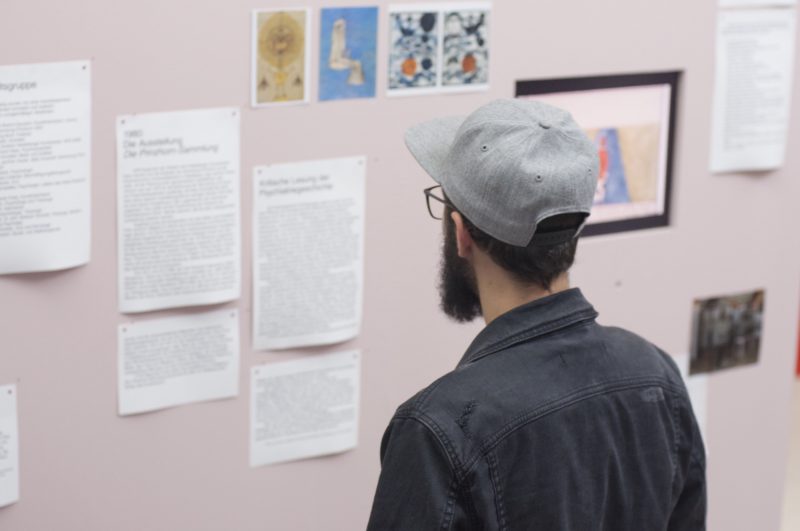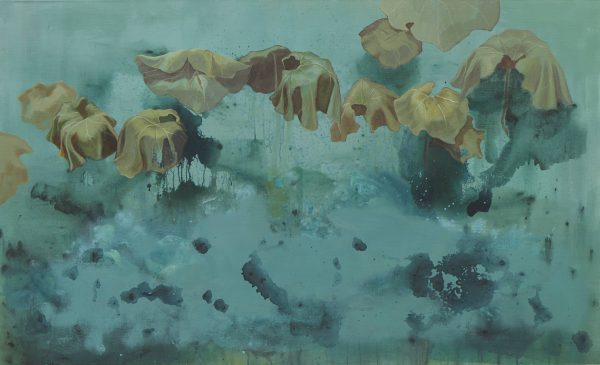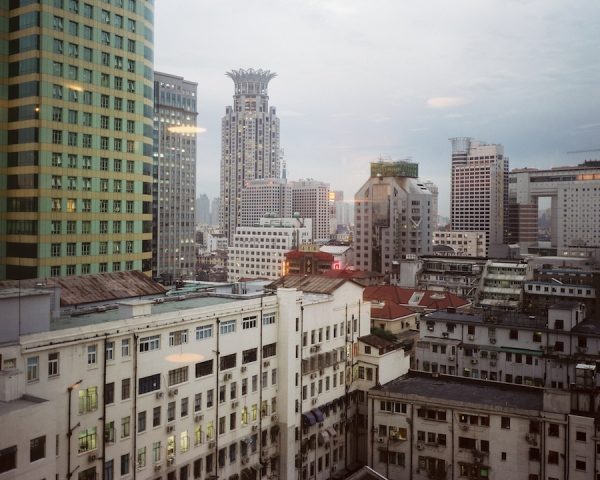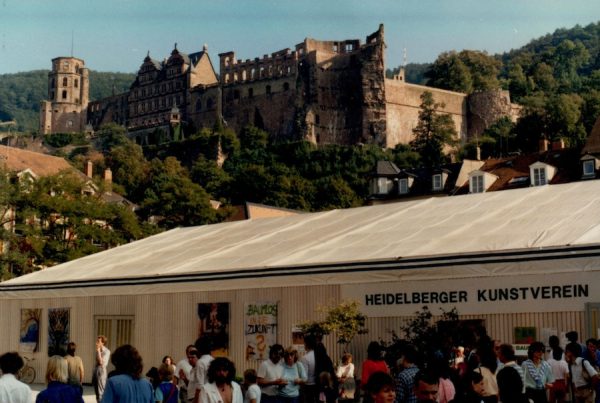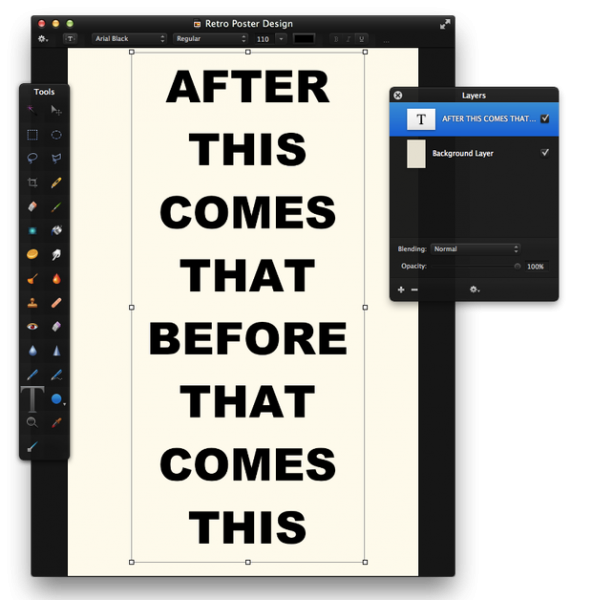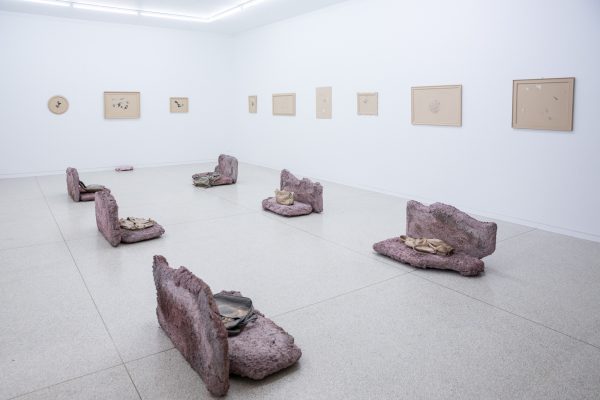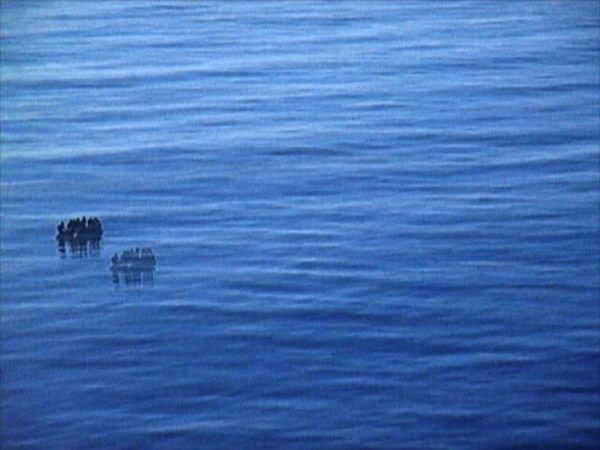Past
Opening: 1.9., 6 p.m.
Artist Talk: 2.9., 2 p.m.
The Heidelberger Kunstverein announces the inaugural exhibition by Eloïse Bonneviot and Anne de Boer in Germany. The project is a culmination of their work to date and explores cultural responses to the accelerating ecological crisis through game mechanics.
The Berlin-based artist duo uses interactive installations and performative works to explore the relationship between humans and other living creatures, climate anxiety, and the construction of worlds. They develop analog and virtual games that stage stories in the midst of ecological collapse.
“Tracing a Seeping Terrain” is an interactive installation that forges new avenues for aesthetic and environmental engagement: The experiential and entertaining aspect of the game is presented as a possible way of facing complex issues of ecological catastrophe, where feelings of guilt and powerlessness often prevail. It has been specially conceived for the Heidelberger Kunstverein and presents an amalgamation of interactive sculptures connected with various speakers and a virtual landscape. Central to this experience is the active engagement of visitors, as their (inter-)actions directly shape the appearance of the simulated landscape and the evocative ambient sounds that envelop them.
As participants in this system, visitors assume the role of active agents within a game narrative, influencing the ecological state of the world they have entered. Equipped with RFID cards, a technology utilizing wireless radio waves to transmit data, visitors can trigger different events. As they initiate these events, the landscape undergoes a metamorphosis: The climate, geology, buildings, and ecosystems change, deteriorate, or speed up. With every interaction, the world’s ecological state is redefined, providing visitors with a thought-provoking experience that explores the balance between agency and environmental consequences.
Alongside the computer-generated fictional landscape demonstrating possible ways to imagine ecologies, the exhibition also encompasses works that draw inspiration from real-world governmental initiatives. These initiatives utilize satellite imagery and geospatial data to create maps for emergency response efforts, such as the Copernicus Emergency Management Service, developed by the European Union and the European Space Agency. They provide information on flood-prone areas, potential landslide zones, and other hazards.
In this context, De Boer and Bonneviot explore the impact of data on our relationship with ecological systems, shedding light on how these technologies communicate, enhance, and simulate natural environments. They also consider the emotions evoked by the dissemination of such data.
The visual language employed by the artists also alludes to projective psychological tests, in which images, often identified as natural motifs, are used as assessment tools. Some of the sculptures in the exhibition feature these motifs, which refer to the human ability to categorize objects based on familiar features and in comparison with memories. This cognitive ability can also be observed in animals and computational systems such as machine learning, which relies heavily on pattern recognition.
The exhibition invites you to playfully explore the interplay between our digital surroundings and the ecosystems they seek to represent, fostering the discourse at the intersection of data, technology, and ecology.
Curated by Johanna Hardt
Supported by Innovationsfonds Kunst des Ministeriums für Wissenschaft, Forschung und Kunst Baden-Württemberg
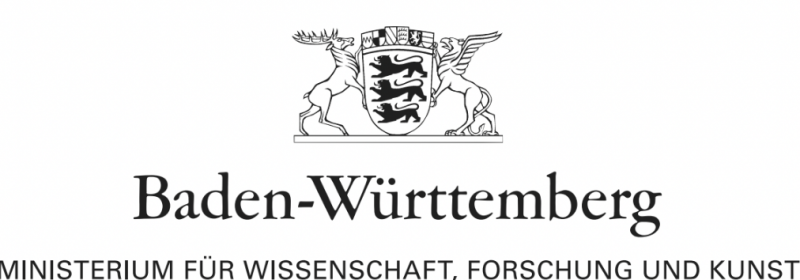
About the artists
Eloïse Bonneviot (FR, 1986) and Anne de Boer (NL, 1987) are a Berlin- based artist duo who explore interspecies relations, climate anxieties, and world-building through interactive installations and performative works. They use games to collectively imagine stories amid ecological collapse, drawing on digital culture and DIY methods. By carefully selecting materials that resonate with their surroundings, they transcend traditional exhibition formats and engage audiences in immersive experiences. Their art inspires reflection and action, providing a compelling platform to reimagine our relationship with the world.
Exhibitions and gaming sessions: a. o. HEK House of Electronic Arts, Münchenstein, CH (2023) Droste Festival, Havixbeck, DE (2023) Capc Musée d’art contemporain de Bordeaux, FR (2022) Athens Biennale 7: ECLIPSE, GR (2021) HAU Hebbel am Ufer, Berlin, DE (2021) Galerie im Körnerpark, Berlin, DE (2020) Bergen Assembly, NO (2019) U-jazdowski, Warsaw, PL (2019) Kunsthaus Langenthal, CH (2017) Royal Academy of Arts, London, UK (2017)
Opening: 1.9., 6 p.m.
With ›Winds of the Anthropocene‹ [1], the Heidelberger Kunstverein presents five artistic films that explore alternative ways of relating to the earth. The positions deal with biological and technological systems and explore the connection between human and non-human history. The works argue for a relationship to the planet that is not shaped by anthropocentrism. They will be presented in a specific order in a loop in the studio of the Kunstverein.
The Anthropocene is our present. Our species has become the dominant geological force, and climate change the unintended consequence. Despite critiques of the deceptive universality implied by the prefix ›anthropos‹ (ancient Greek for ›human‹), it remains the most popular label for our geological age. The selected films trace this problematic legacy of modernity and refer not only to the ecological but also to the social and cultural impacts associated with human activity.
The films deal with seemingly new technologies but also with the past–with remnants of the natural world, ecosystems, and indigenous cultures destroyed by human activity. They challenge the modern mind, which takes the world for granted, forcing it to learn from what it considers obsolete. They call for thinking in larger temporal dimensions defining humans as a ›minority form of life‹ [2] among a majority of other life forms.
Sybille Neumeyer’s ›Souvenirs entomologiques #1: odonata / weathering data‹ (2020) explores the entanglements of humans, weather, and insects in a data-driven world. It follows dragonflies from their geological past into uncertain futures, from their ecosystems to museum collections, and from the transformation of weather worlds into data clouds, all while multiple insect identities are mediated, shaped, and reshaped by modes of mapping, monitoring, and collecting.
A plant speaks to us in Kyriaki Goni’s CGI video: ›The mountain-islands shall mourn us eternally (Data Garden Dolomites)‹ (2022). Data gardens, we learn, are networks of plants that store and circulate digital information all over the planet. Using this hypothetical scenario and appropriating elements from recent scientific research on the data storage capacity of the genetic material of living organisms, the work explores DNA as a technical medium.
The protagonists in Heather Dewey-Hagborg’s film ›Hybrid: an Interspecies Opera‹ (2022) are real humanoid pigs genetically modified to be suitable as heart donors for transplants. It questions whether CRISPR gene editing represents a radical break with or a continuation of the millennia-old practice of selective breeding.
In ›These Networks In Our Skin‹ (2021) by Mimi Ọnụọha four women are rewiring internet cables, filling them with hair and spices–materials associated with ritual and community. They insert themselves into the tech infrastructure and make us realize how they are replacing other cultural values already imbued there.
›4 Waters-Deep Implication‹ (2018) by Denise Ferreira da Silva and Arjuna Neuman retells the Haitian Revolution by linking it to an earthquake in 1784. This earthquake is the catalyst for the revolution–an indigenous prediction of black independence. Through four waters–the Mediterranean, Atlantic, Pacific, and Indian oceans–and the islands Lesvos, Haiti, Marshall Islands, and Tiwi, the film addresses pressing global issues such as the legacies of colonialism and ecological devastation, excavating the link between geological shifts and knowledge production.
Curated by Johanna Hardt
[1] Tsing et al., Arts of Living on a Damaged Planet, 1.[2] Chakrabarty, The Climate of History in a Planetary Age, 195.
About the artists
Sybille Neumeyer is an artist and researcher focusing on human-non-human relations and ecology. Her research draws on various fields of knowledge, often in collaboration and exchange with scientists and experts. Through installations, workshops, lectures, and video essays, she explores the intersections of biological and cultural loss of diversity, climate crisis, and more than human health. Exhibitions/projects (selection): Charité Berlin (DE); Art Laboratory Berlin (DE); Onassis Stegi, Athens (GR); Kunsthaus Dresden (DE); EXiS, Seoul (KR), ZKM Karlsruhe (DE); Museum für Naturkunde, Berlin (DE).
Kyriaki Goni explores technology's political, affective, and ecological aspects. Her work focuses on extractivism, surveillance, human and non-human relations, distributed networks, and infrastructures. Exhibitions (selection): The Breeder, Athen (GR); Drugo More, Rijeka (HR); SixtyEight Art Institute, Copenhagen (DK); Kunstverein Ost, Berlin (DE); Onassis Stegi, Athens (GR); Museum für zeitgenössische Kunst, Ljubljana (SI); Kunsthalle Mannheim (DE); Microwave International New Media Arts Festival, Hongkong (HK); 2. Warschau Biennale (PL); 13. Shanghai Biennale (CN); Ars Electronica, Linz (AT); Kunsthalle Tallinn (EE); transmediale, Berlin (DE).
Heather Dewey-Hagborg is an artist and biohacker interested in art as research and technological critique. Her controversial biopolitical art practice includes the project Stranger Visions, in which she created portrait sculptures from analyses of genetic material collected in public places. Exhibitions (selection): World Economic Forum, Davos (CH); Daejeon Biennale (KR); Guangzhou Triennial (CN); Shenzhen Bi-city Biennale of Urbanism\Architecture (CN); transmediale, Berlin (DE); Walker Art Center, Minneapolis (US); Philadelphia Museum of Art (US); PS1 MoMA, New York (US). Collections: Centre Pompidou, Paris (FR); Victoria and Albert Museum, London (UK); SFMoMA, San Francisco (US).
Nigerian-American artist Mimi Ọnụọha's work questions and exposes the contradictory logics of technological progress. Through print, code, data, video, installation, and archival media, Ọnụọha offers new orientations for making sense of the absences that define labor, ecology, and relations systems. Exhibitions (selection): bitforms gallery, New York (US); Forest City Gallery, London (UK); Whitney Museum of American Art, New York (US); Australian Centre for Contemporary Art, Melbourne (AU); Mao Jihong Arts Foundation, Shanghai (CN); La Gaîté Lyrique, Paris (FR); transmediale, Berlin (DE); The Photographers Gallery, London (UK); NEON, Athens (GR).
Arjuna Neuman is an artist, filmmaker, and writer who uses the essay as a futuristic and experimental mode guiding his research and production. Denise Ferreira da Silva is an artist and philosopher concerned with the ethico-political challenges of the global present. Neuman and Ferreira da Silva's artistic collaboration stems from their shared research and perspective on the world as a landscape where humans and environmental elements, such as geology, bacteria, and weather, are interconnected. Exhibitions/Screenings: Centre Pompidou, Paris (FR); Whitechapel Gallery, London (UK); 56. Biennale Venedig (IT); Haus der Kulturen der Welt, Berlin (DE); Institute of Contemporary Arts, London (UK); Julia Stoschek Foundation, Berlin (DE); Museum Arnhem (NL); Berlinale Forum Expanded (DE). Collection: Belkin, Vancouver (CA).
Opening: Friday, June 9, 2023, 6 p.m.
A cooperation with the Institute for European Art History at Heidelberg University
Opening: 26/5/2023
Heidelberger Kunstverein announces the major solo exhibition Savoir Vivre by artist Agnes Scherer (*1985).
Amidst the Kunstverein’s hall, visitors face the sinister image of a chivalrous fight. Two knights on their horses are galloping toward each other. One is just being hit by the lance of his opponent. Twelve court ladies are watching the scene.
The depicted life-and-death competition does not take place in reality. The knights and ladies turn out to be sculptures made of painted paper-mâché. The facial expressions and postures of the figures seem puppet-like. No blood flows.
For her new project, Savoir Vivre Scherer has transformed the hall into a medieval tournament to problematize the persistence of the culture of “courtly love (German: “hohe Minne”) and its idealization of “the lady” as the object of desire and source of competition in patriarchal societies: Widespread in Europe throughout the Middle Ages, “courtly love” was characterized by a series of stylized rituals between a knight and a married lady of high rank. In popular culture, the concept is closely linked to fantasies of romantic liaisons or colorful jousting tournaments observed by adoring female spectators.
The puppet-like court ladies are actually hollow figures, as visitors will discover on closer inspection. Their eye holes direct the viewer’s gaze to the scene below, where the martial masculinity of the knights is put on display. With this direction of the gaze–namely with the manipulation of different perspectives–Scherer reflects on the gap between the active experience of the tournament fighters and the passive spectatorship of the women on the tribune. For we do not know how women in the High Middle Ages actually experienced the tournaments that were supposedly held in their honor. The female perspectives on the events are impossible to reconstruct. The walk-in hollow figures embody this void in historical knowledge.
Scherer caricatures how symbolic elevation corresponds to women’s actual degradation. Her artistic research shows: After tournaments, “Minne” poet knights boasted about their “consumption of lances,” the wearing away of material and life in a display of honor, to the benefit of no one. Thus, the project also illustrates how the idealized customs of “courtly love” serve as a blueprint for the heteronormative bourgeois concept of love and its neurotic content.
In the city of Heidelberg, Savoir Vivre is a site-specific project. Consider the immense effort that Heidelberg’s cultural leaders put into returning the Codex Manesse – a medieval manuscript of illustrated Middle High German courtly love lyrics (German: “Minnesang”) back to the University Library after World War II. And in the Baden-Württemberg region, numerous medieval spectacles and re-enacted jousting tournaments are held, including the annual medieval market in Esslingen and the jousting games in Horb am Neckar or at Kaltenberg Castle in Upper Bavaria, where martiality is staged “authentically.” Savoir Vivre thus raises the politically charged question of why so many people today are longing for a world whose social structures were based on stereotypical gender roles and an authoritarian class system that could hardly be overcome.
Curated by Søren Grammel
Supported by STIFTUNG KUNSTFONDS
About the artist
Agnes Scherer (born 1985 in Lohr am Main, Germany) lives in Berlin and Salzburg. She studied painting at the Düsseldorf Art Academy.
In 2015, Scherer's first operetta Cupid and the Animals was awarded the Nigel Greenwood Art Prize and performed at Museum Ludwig in Cologne (2017) and Tramps in New York (2018), among other venues. Her work has been presented internationally in group and solo exhibitions, including at Cabaret Voltaire in Zurich, Project Space 1646 in The Hague (both 2020), and Kinderhook & Caracas in Berlin (2019). In 2019, she received the Berlin Art Prize. She works with the galleries CherdLüdde (Berlin) and sans titre (Paris).
Exhibition and Discourse Program
Duration: February 18th to April 30th, 2023
With Matter of Alliances, HdKV presents Marwa Arsanios’ first solo exhibition in Germany. It focuses on the artist’s interdisciplinary approach dedicated to ecofeminist and decolonial practices.
Arsanios’ cross-media installations—which include film, textile, print, drawing, collage, furniture, and archive materials—are based on extensive periods of travel and research. The Lebanese artist, born in 1978, focuses on grassroots organizations concerned with ecology, land distribution and agriculture, community building, feminist politics, and radical democracy.
At the center of the exhibition is the ongoing project Who Is Afraid of Ideology? which began in Iraqi Kurdistan in 2017. It shows strategies of resistance by women defending their right to land and water in places such as Northern Syria, Lebanon, and Colombia. Their survival depends on protecting their environment. Yet, the state continues to discredit the activists systematically and deprive them of their rights.
The engagement with local agents of these networks defines the artist’s work. She highlights figures like Djamila Bouhired, an icon of the Algerian independence war, and other women in Arabic speaking countries to counter the mainstream portrayal of women in that part of the world as automatically oppressed. Her work calls on us to recognize that groups constructed as ›weak‹ in Western discourses can be self-sustaining creators of progressive strategies. While Western industries and lifestyles are the primary cause of the climate crisis, innovative alternatives are being developed by those most affected. Indigenous groups, local initiatives, and self-organized communities fight to protect their environment against international corporations and political repression. With their resistance, they demonstrate how a crisis can birth creative action.
Arsanios marks a new aesthetic perspective within the discourse shaped by Gayatri Spivak, co-founder of postcolonial theory, in her 1988 essay Can the Subaltern Speak?. At the same time, the artist expands the critique of the Eurocentric discourse to include alternative narratives of the Anthropocene: how can a new feminist and ecological consciousness contribute to its transformation? It is about time that we replace the paralyzing concerns about the end of the world with innovative and alternative models of care for the planet. How can human destruction of nature open up new fields of action?
In Arsanios’ own words: ›In light of the urgency on the climate change issue, and while governments and corporations have been ignoring it for decades now without wanting (most often) to take any responsibility on the matter, women farmers have been mobilising their means and knowledge to carry out the work of repair. I believe this kind of resistance front to climate change should be enhanced, learned from and worked with intensively.‹
Søren Grammel and Mehveş Ungan, curators of the exhibition
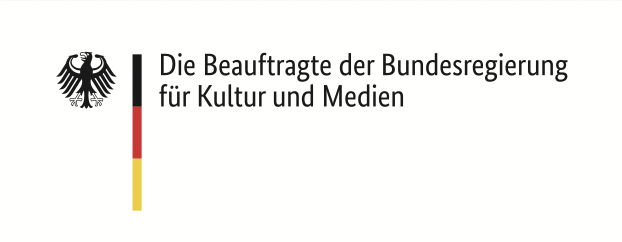
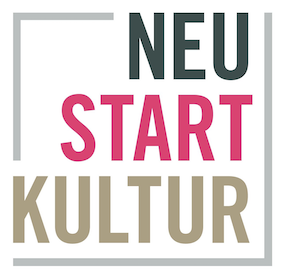
The project is generously supported by Stiftung Kunstfonds, NEUSTART plus – Plattformen der Bildenden Kunst.
CV
Marwa Arsanios (*1978) lives in Berlin and Beirut. Her works were most recently on view at the documenta fifteen (Kassel) and The Mosaic Rooms (London). She graduated with an MFA from the University of the Arts, London (2007). Afterwards, she worked as a research assistant in the Department of Fine Arts at the Jan Van Eyck Academie (2011-12). Arsanios is currently a PhD student at the Academy of Fine Arts in Vienna, and teaches at the Dutch Art Institute.
Selected solo exhibitions: at the Contemporary Arts Center, Cincinnati (2021); Škuc Gallery, Ljubljana (2018); Beirut Art Center (2017); Hammer Museum, Los Angeles (2016); Witte de With, Rotterdam (2016); Kunsthalle Lissabon, Lisbon (2015); Art in General, New York (2015).
Selected group exhibitions: documenta fifteen, Kassel (2022); 5th Mardin Bienali (2022); 11th Berlin Biennale (2020); 2nd Lahore Biennale (2020); Kunsthalle Wien, Vienna (2019); 1st Sharjah Architecture Triennial (2019); SFMOMA, San Francisco (2019); 1st Warsaw Biennial (2019); Nottingham Contemporary (2017); Ludwig Museum, Cologne (2016); New Museum, New York (2014); 55th Venice Biennial (2013); 12th Istanbul Biennial (2011).
Screenings: Cinéma du Réel, Paris (2021); Rotterdam Film Festival (2021); Film Fest, Hamburg (2020); Walker Art Center, Minneapolis (2017); Centre Georges Pompidou, Paris (2011, 2017); International Film Festival Berlin (2010, 2015); e-flux storefront, New York (2009).
Prizes: Georges de Beauregard International Award, FID Marseille (2019), Pinchuk Future Generation Art Prize (2012).
Scholarships: Stuttgart Akademie Schloss Solitude Scholarship (2014), Tokyo Wonder Site, Tokyo Arts and Space (2010).
Simon Denny’s (*1982) exhibition ‘Merge’ results from the artist’s longstanding engagement with different technologies and politics of extractivism, the mining and monetisation of raw materials. The project explores the supposed logic of economies that make screens glow and computers calculate, cars drive, and trade fairs trade on a worldwide basis. What mechanisms and ways of thinking shape the global on- and offline industries that determine the consumption of natural resources as well as post-colonial power relations? In Denny’s work, the question of how alternative models can be generated through the use of the internet always resonates. The project is part of an exhibition series at the Heidelberger Kunstverein that began last June with Alice Creischer and will continue next year with Marwa Arsanios.
A huge floor graphic in the HDKV hall marks the beginning of Simon Denny’s ‘Merge’. It shows the surface of the classic Australian board game Squatter, its placement reminiscent of the experience-oriented exhibition design of technology museums. While Monopoly players can imagine themselves as real estate tycoons, Squatter turns them into sheep farmers competing for grazing land, flock size, and wool sales. The game not only reflects the history of settlement in Australia and New Zealand, but also references an archetypal form of extractivism still closely associated with physical labour.
On this both aesthetically and thematically crucial backdrop, Denny distributes a series of large-scale sculptures constructed from sturdy honeycomb cardboard. The pieces are based on representations of modern semi-or fully automated machines and technologies from the spheres of mining, geodata capture and productivity management. The rock-breaking hydraulic hammer from Transmin, the geodata-collecting satellite from US giant DigitalGlobe, the drilling rig simulator from market leader Epiroc, and a biometric smart-band to monitor workplace fatigue all appear on the colourful Squatter board like a strange techno theme park. Denny had the machines’ original industrial look translated into a dystopian gaming aesthetic by game designer Paul Riebe.
This is fitting, on the one hand, because some of the apparatuses depicted are in reality high-tech robots filled to the brim with digital smart power, to be operated by workers as though they were computer games. An example is the Epiroc simulator, which is animated as a good-natured Transformer in the accompanying promo video. On the other hand, Denny’s approach is obvious: after careful observation, we begin to ask ourselves to what extent all these machines are not simply big toys, developed by gambling men who imagine the planet as an oversized sandbox. This made evident by the sometimes devastating ecological consequences and the political entanglements that come into play when it comes to granting permits and circumventing inconvenient regulations, as well as the often inhumane practices towards local workforces—especially in the Global South—are defining features of extractivism. This is why Denny also invited the courtroom artist Sharan Gordon to create a series of authentic-looking courtroom drawings to accompany each of the machines, involving the individual corporations behind them, showing real people—CEOs and executives—during fictional accountability trials.
Some of the sculptures also serve to present the board game Extractor, which Denny developed together with Boaz Levin. While Squatter still turns players into well-behaved sheep farmers, in Extractor, they become managers of data-oriented companies, learning to capture and monetise Big Data from online activities or circumvent onerous constraints such as carbon taxes. In this way, the game not only conveys basic mechanisms of digital “surveillance capitalism” (Shoshana Zuboff, 2018), but also shows extractivism as a prevailing principle of current politics: those who ‘pull out’—the extractivist character already becomes clear in this verb—the maximum level of material and immaterial resources from oneself, the others, and the environment, win.
The notion of extractivism as a principle that shapes all kinds of relationships across social spheres is continued on the upper floor of the Kunstverein through the reference to the mining, or ‘extraction’—another linguistic gesture towards extractivism—of cryptocurrencies. The objects in the Centralization vs Decentralization hardware display series are fully functional mining rigs. During the exhibition, they will be actively involved in mining new cryptocurrency. They are simultaneously works of visual art, too. In addition to the relays of graphics cards that were, and still are, used as part of the blockchain infrastructure of a decentralised web, Denny mounts components such as printed board games or Reddit fan art on derelict casing parts formerly used for central mainframe computer systems—infrastructure which represents precisely the order that advocates of decentralised blockchain systems want to disrupt. Collaging components of conventional systems with their antithesis is not an explicitly formal trick, but rather, a reference to disputes that are taking place surrounding the distribution of power on the web. This is about the demand for a democratic internet whose control no longer lies in the hands of a few giants, namely GAFA (Google, Apple, Facebook, and Amazon).
The title of the exhibition, ‘Merge’, alludes to the long-awaited and recently realised merge of the Ethereum network with the Proof-of-Stake (PoS) consensus algorithm. Prior to the merge, Ethereum used Proof-of-Work, the method made popular by Bitcoin, for validating virtual transactions—one which consumes massive amounts of energy. With PoS, it is no longer the computing power of the miners and extra hardware, but the share of coins they hold on the network, that determines their validating power. Thus, ‘the merge’ will drastically reduce energy consumption—some say by up to 99.95%.
Through the way Denny interprets technology, he always raises the essential question of how we want to shape our world and lives.
Søren Gammel, curator of the exhibition
Simon Denny (b. 1982 in Auckland, New Zealand) lives and works in Berlin. He studied at the Elam School of Fine Arts at the University of Auckland and at the Städelschule in Frankfurt am Main and is co-founder of the artist mentoring programme BPA// Berlin Program for Artists. Denny also holds a professorship for time-based media at the Hamburg University of Fine Arts.
Solo exhibitions (selection): Dotcom Séance at folia.app, www.dotcomseance. com (2021), K21 Kunstsammlung Nordrhein-Westfalen, Düsseldorf (2020); Museum of Old and New Art (MONA), Hobart (2019); Museum of Contemporary Art (moCA), Cleveland (2018); OCT Contemporary Art Terminal (OCAT), Shenzhen (2017); Hammer Museum, Los Angeles (2017); WIELS Contemporary Art Centre, Brussels (2016); Serpentine Galleries, London (2015); MoMA PS1, New York (2015); Portikus, Frankfurt am Main (2014); mumok—Museum moderner Kunst Stiftung Ludwig Wien (2013); Kunstverein München (2013).
Denny represented New Zealand at the 56th Venice Biennale in 2015.
As a curator, he has realised major exhibitions on blockchain and art, including ‘Proof of Stake’ at Kunstverein in Hamburg (2021) and ‘Proof of Work’ at Schinkel Pavillon in Berlin (2018).
His works form part of institutional collections, including Hamburger Kunsthalle, Kunstsammlung Nordrhein-Westfalen (Düsseldorf), MoMA (New York), Walker Art Center (Minneapolis), Kunsthaus Zürich, Sammlung zeitgenössischer Kunst der Bundesrepublik Deutschland (Berlin), and Museum of New Zealand Te Papa Tongarewa (Wellington).
Heidelberger Kunstverein is pleased to announce first joint exhibition of the Mannheim-based artists Katinka Eichhorn (b. 1993) and Jordan Madlon (b. 1989). Their image-objects move between painting, sculpture, poetry, assemblage, and drawing, whilst extending the critique of medium-based categories.
Their pieces made from textiles, paper, wood, and aluminium hang on the wall, divide space—inside from outside—implode, bend, and withstand. Two-dimensional planes are sewn together, printed on and filled. They expand in space, and become bodies. In addition to the choice of fabric and the type of filling material, gravity and the way they are hang affect the resulting shapes. Simultaneously, there is an undeniable openness, elasticity, and dynamism immanent in their works—regardless of whether materials are malleable, reacting with slight adjustments to your body movement, or whether they seem fixed like stencilled lettering. For where the material is hard, the forms are all the more softer. It is as if by imitating the pliable presence of objects made from textiles, rigid shapes appear to become fluid.
Hence, the differently layered cutouts of wood and aluminium may appear stiff at first glance, yet they suggest movement. From a horizontal axis that forms a counterpart to the floor, some forms seem to flow downward, while others strive upwards against gravitational force. Deliberately placed blank spaces in the works further enhance this dynamism on display here. As details, these ›cutouts‹ draw attention to what is omitted as well as to the process of omission. Functioning as interruptions and fragments, they simultaneously place the potential of supplementation within representational space, and thus engaging the viewer in the structure of the work.
The exhibition ›Where Space Wings By‹ relates to the idea of in-betweenness that manifests itself materially in individual works but also metaphorically as the overarching connection between both artistic practices. The artists themselves describe this ›in-between space‹ as an invisible space. The works are expected to make this quality tangible.
To direct one’s attention to the in-between means endeavouring to understand situations constituted by movement and mediation. As a (strangely slippery) condition, artistic in-between space also allows one to escape the essentialism that dominates Western logic in its search for the true nature of things, and dividing the world into ideas of ›this‹ or ›that‹. In Eichhorn and Madlon’s work, space is not just a physical container, it is also activated as a dynamic phenomenon of semantic ambiguity.
Interestingly, Hilde Domin’s poem Unaufhaltsam (1994), about the power of (uttered) words, inspired the artists for their exhibition. From the poem, the line ›Wo das Wort vorbeifliegt‹ (Where the word flies by) was adapted so that ›word‹ was replaced by ›space‹. In this way, the latter’s agency is expressed. It is not without reason that the exhibition focuses more on exploring spatial relationships and less on questioning representational space or the meaning of individual visual elements as signs.
Katinka Eichhorn (b. 1993 in Hamburg, Germany) creates objects from textiles. Drawings play an integral role in this process. They are her response to personal memories, observations, and precise measurements. Eichhorn then translates the lines of these ›drawn deliberations‹ onto textiles. Sometimes it manifests itself as a seam that brings a part of a hidden layer of fabric to the fore. At other times, it forms scarcely perceptible seam patterns. The interaction between negative and positive space, fragmentations, symmetries and their dissolution are recurring elements in her compositions.
Jordan Madlon (b. 1989 in Les Abymes, Guadeloupe) explores colour, form, and space through various techniques. His sculptural image compositions consist of the combination of wood, paper, aluminium, and textile cutouts. In his ›print-objects‹, he expands on the medium of woodblock printing; fabric becomes the bearer of the image whilst dictating its shape. Playful articulations of lines and letters characterise his vocabulary. From a collection of small pieces of paper, remnants of cuttings, and notes, he assembles compositions that he calls ›remarks on time and duration‹.
CVs
Jordan Madlon (b. 1989 in Les Abymes, Guadeloupe) lives and works in Mannheim. From 2008–2014 he studied at École Supérieur d‘Art et de Design de Saint-Étienne (FR). After his graduation, he undertook a postgraduate programme with Prof. Helmut Dorner at Staatliche Akademie der Bildenden Künste in Karlsruhe from 2014–2016. He was awarded the Kunstart prize by François Schneider Foundation in 2017 and a stipend from the Kunststiftung Baden-Württemberg in 2019.
His works are represented in several public collections, among them the François Schneider Foundation in Wattwiller (FR), MWK Baden-Württemberg (D) and FRAC Auvergne (FR).
Recent solo shows include ‘Diagrammatisch’, Kunstmuseum Reutlingen | Spendhaus, 2021; ‘former la langue’, COHERENT, Bruxelles (BE), 2019–2020; ‘Un amour si grand qu’il nie son objet’, Kunststiftung Baden-Württemberg, Stuttgart (D), 2019; ‘Du caractère de la nuance’ (with Julie Digard), Luis Leu, Karlsruhe (D), 2019; ‘Seine Zunge im ZRaum halten’, V8 Plattform für neue Kunst, Karlsruhe (D), 2018.
Recent group shows include ‘Burden Painting’, LAUBE Karlsruhe Binome, duo exhibition with Rémy Hysbergue; ‘For real?!’, Kunstverein Reutlingen (D), 2022; ‘Zig Zag’, Kunstverein Bad Durkheim (D), 2021; ‘After School’, Artpress Biennal of Young Artists, Musée d’art moderne et contemporain de Saint-Étienne Métropole (FR), 2020; ‘49°—Offene Ateliers’, initiated by Badischer Kunstverein and BNN, Karlsruhe (D), 2018; and ‘Jeune Création: °67ème Édition’, Thaddaeus Ropac, Paris (FR), 2017.
Katinka Eichhorn studied at the Academy of Fine Arts Karlsruhe and the Academy of Fine Arts Vienna. She was an artist in residence at L'Association Saint Henri, Castelnaudary, France, in 2017. She was awarded studio funding from the city of Mannheim, where she currently lives, until 2026.
Group exhibitions include ‘fragments of a glimpse’, two decks, Altes Güterhalleamt, Mannheim, 2022; ‘Ich habe dich zum fressen gern’, Kontingent Kollectiv, Munich, 2022; Betriebswerk, Heidelberg, 2021; ‘Zig Zag’, Kunstverein Bad Dürkheim, 2021; ‘unter Vorbehalt’, Luis Leu, Karlsruhe, 2020; ‘Give me a reason’, Gellertstraße Karlsruhe, 2020; ‘Schlafen werden wir später’, Kalinowskiraum, Karlsruhe, 2019; Examensausstellung, AdBK Karlsruhe, 2019; ‘Z wie Zartheit’, Orgelfabrik Karlsruhe Durlach, 2018; ‘Indra, Transmogrified’, Kunstverein Pforzheim, 2016; ‘Gold war Gestern’, Ciao - Kunstraum, Karlsruhe, 2015.
For Heidelberger Kunstverein, artist Céline Condorelli creates a space to sit, wait, read, learn, meet, speak, lecture, listen, discuss and think.
Collective activation on Saturday, June 11 at 4 pm.
Ongoing project.
With her Support Structures, Céline Condorelli changes how we understand and use institutions.
Revision -part II consists of a modular system of six newly produced units that visitors can easily move around. The mobility of the structures allows for flexibility in terms of usage and function. In this vein, visitors and employees of the Kunstverein alike can generate numerous scenarios by collectively utilising the structures to their needs.
The project thus transforms the entrance area of the Kunstverein into a learning environment for testing out ideas around spectatorship, engagement and participation. For example, the units can be connected to construct a performance space or an auditorium, joined together to create a communal workspace, or simply be used as a place to rest. Revision -part II thus plays with historical and contemporary learning contexts, where the arrangement and appropriation of elements is part of the learning process.
Activated by ongoing cooperation with the art historical, sociological and pedagogical faculties of the University of Heidelberg – the latter represented by members of the board of the Kunstverein – the project explores the relationship between exhibition and pedagogy through different disciplines.
Originally, Revision -part II was designed by Condorelli as a spatial context for a provisional and alternative art academy. A place for individuals to become students, experiment with different learning practices and investigate the possibility of reinventing the classroom or lecture format where learning usually takes place.
While the individual elements of the installation appear fixed in their formal and physical coherence, the relationship between them is dynamic and mobile. Hence, the identity of the elements transforms in the course of their movement and appropriation by the users. This means that a visually unified object can nevertheless be used as a sculpture, an office, a learning space, an archive, etc.
The objects and their setups are not answers to questions but rather form spaces of action where a problem can be negotiated and worked on.
Educational Turn and Revision -part II at the Heidelberger Kunstverein
A range of art projects that foreground the pedagogical led to the so-called Educational Turn in the 2000s. (Cf. e.g., Paul O’Neill & Mick Wilson, Curating and the Educational Turn (Open Editions/de Appel, 2010)). Whereas educational activities have always been part of the programs of exhibition venues, they mainly held a subordinate role. The Educational Turn describes educational formats becoming the primary concern in artistic and curatorial practices, as seen in numerous art institutions, but also in the context of biennials and temporary projects.
Revision -part II at the Heidelberger Kunstverein by Céline Condorelli acknowledges these developments and situates itself in this context.
The project is accompanied by various measures to open up the institution, such as free admission to the Kunstverein’s exhibitions from June onwards.
About the artist:
Céline Condorelli (b. 1974) lives and works between London and Milan. Her work includes architecture, furniture design, art and exhibition design. She currently works as a professor at the NABA (Nuova Accademia di Belle Arti) Milan and is one of the founding directors of Eastside Projects (Birmingham, UK). As a writer and editor, she is also known for the publications The Company She Keeps and Support Structures.
Notable exhibitions and projects include: After Work (South London Gallery, 2022); The Stories We Tell Ourselves (Kunstverein München, 2021); Every Step in the Right Direction (Singapore Biennial, 2019); Art Encounters Biennial (Timisoara, 2019); Céline Condorelli (Kunsthaus Pasquart, Biel, 2019).
In 2017, Condorelli was nominated for the Max Mara Art Prize for Women.
Special thanks to the H+G BANK Foundation for supporting the project.
Exhibition Opening on Saturday, June 11 at 4 p.m.
Duration from June 12 to September 11, 2022
Reading by Alice Creischer (with Søren Grammel, curator) on Sunday, June 12 at 3 p.m.
›You poor take courage. You rich take care. The earth was made a common treasury. For everyone to share!‹ (from ›The World Turned Upside Down‹, British anti-establishment ballad from the 1640s; first published as a pamphlet)
With this exhibition, Heidelberger Kunstverein refers to its urban context: Heidelberg, the city of sciences, housing the oldest university of Germany. The establishment of matters of facts was the guiding principle of the early empirical sciences. They introduced a new power to the world: the power of facts. Experimental research was supposed to deliver truths on its own accord, unaffected by belief systems and free from dominant interests. In short, pure facts.
The artist Alice Creischer, born in 1960, has deliberately mistranslated this motto of the 17th century into Das Etablissement der Tatsachen. That title may sound disreputable, yet, not without reason. Creischer’s detailed installation shows that the normative power of the factual is a regime in its own right, formed by economic and political interests.
At the centre of Creischer’s installation is the free reconstruction of a vacuum pump that scientist Robert Boyle, a founding member of the Royal Society, used in the 1660s to prove the existence of the absence of air from a space. His claim led to an argument with the political theorist Thomas Hobbes: Whilst Boyle intended to arrive at truth through technical tools and the help of neutral observers, Hobbes insisted that scientific insight had to submit to the power of the absolute ruler, the Leviathan. He feared that if the existence of a vacuum could be proven solely through experiments without considering the laws of pure reason and political philosophy, this space would be exempt from government control and might even provoke a political vacuum, i.e., anarchy and civil war.
Boyle went to tremendous lengths to make his vacuum pump leakproof until it could suffocate lab mice. Far from creating anarchy, he, instead, invented death in the laboratory to demonstrate physical facts. Using the family trees, scientific classifications, and genetic codes of countless generations of lab mice, Creisher unfolds her expansive installation. She connects Boyle’s experiments with present-day political events to denounce the illusion of knowledge existing separated from power.The artist guides the spectator through a dense parcours of images, collages, objects and encoded poems. In addition, the exhibition features a theatre script, written in four acts and accompanied by a detailed and challenging to decipher source appendix. Encryption and the deliberate withholding of information are the defining characteristics of the exhibition’s semantics. Here, too, to understand is to appropriate. Knowledge is not something we just find. What can be known and what cannot is subject to conditions—for the one who speaks and the one who listens. No fact is innocent; neither is the knowledge of it, nor its critique.
About the artist
Alice Creischer (b. 1960) lives and works in Berlin and has, since the 1990s, been considered an influential figure in the theoretical and political discourse of the German art scene. For a long time, she was a regular contributor to the art maga- zines Texte zur Kunst and springerin.
Exhibitions include: Arbeit, Arbeit, nichts als Arbeit (Galerie Wedding, Berlin, 2019); Circular Flow–Zur globalen Ökonomie der Ungleichheit (Kunstmuseum Basel, 2019); The School of Kyiv (Kyiv Biennial, 2015); Social Fabric (Institute of International Visual Arts, London, 2012); Apparatus for the Osmotic Compensation of the Pressure of Wealth During the Contemplation of Poverty (MACBA, Barcelona, 2008); documenta 12 (Kassel, 2007); The Greatest Happiness Principle Party (Secession, Wien, 2001).
As a curator, she has worked on important exhibitions around the critique of neoliberalism and colonialism, i. e. Die Gewalt ist der Rand aller Dinge (2002); ExArgentina (2004); Das Potosí-Prinzip (2010 / 2011).
 Alice Creischer, ›Das Etablissement der Tatsachen‹, Eröffnung der Ausstellung, Heidelberger Kunstverein, Foto: Lys Y. Seng
Alice Creischer, ›Das Etablissement der Tatsachen‹, Eröffnung der Ausstellung, Heidelberger Kunstverein, Foto: Lys Y. Seng
Exhibition Opening on Saturday 11 June from 4 p.m
Duration from June 12 to August 28, 2022
What happens when we define reality increasingly on the basis of experiences generated for us by the media? How are our perceptions of our surroundings and our understanding of social status, personal identity and sexuality changed by constantly checking these aspects of life against mass media content?
These are the questions addressed by Philipp Timischl in his work, for which he processes personal experiences and relates them to a range of mass media themes and genres. One example is the LED sculpture Kim and Kourtney FIGHT over Work Ethic (2021) featured in the exhibition that combines fake fur and spray paint with a clip from the series “Keeping up with the Kardashians”. In the chosen scene with Kim and Kourtney, the two millionaire sisters are arguing about their work ethic: while one wants to make her mother proud, the other counters that she’d rather be a good mother herself. By reducing the playback speed of the video by half, the individual statements in the exchange take on an extraordinary presence and an absurd poetry. The focus is on the appropriation and interpretation of social codes and the rules of what passes for good taste, marking the individual’s position within society and determining whether they are included or excluded. Timischl’s work often highlights the subtle boundaries of bourgeois culture by willfully breaching or playfully transgressing codes considered or claimed to be legitimate.
The exhibition centers on the premiere of the spectacular new LED sculpture Reality is the worst-case scenario, LA to NY (Austin) (2022). The work is based on short video sequences, edited together with extremely fast cuts, that were shot over several weeks during a road trip across the United States by the artist and friends. The large-scale video wall was designed by Timischl to fit the exhibition space at Heidelberger Kunstverein, confronting the viewer with a complex montage of highly diverse, overlapping information. Matching the fast cut style, the land- scapes and urban / suburban settings are accompanied by snatches of the travelers’ conversation and songs from the radio. On a second synchronized screen, Timischl also shows maps showing the travelers’ progress, like the display of a navigation system. In other words, more information than can be absorbed by visitors, forcing them to choose between multiple elements of text, image and sound. The frag- mentary conversations touch on many and varied themes, a seemingly endless range, in some cases arbitrary and highly condensed: death, life and gas prices; religion, friendship and Beyoncé; intensive livestock farming, unpaid work and the weather. While Beyoncé sings: “I was here, I lived!”.
By playing with this excess of information, Timischl initially suggests we are seeing real footage from a stereotypical road trip across the United States. As we watch, however, we begin to wonder whether this reality may have been faked, since the work contains a surprising number of coincidences: one of the people in the car tells of not being given an internship because she didn’t show enough interest in it, while on the radio Usher sings, “get that money, money, money”. Or can it be chance that the car is driving through an oil field in Texas when the group realizes they’ve run out of gas again?
Once sensitized to such phenomena by Timischl’s work, even the most fleeting scrap of image or sound suddenly seems to be at least potentially contrived, a reality shaped by the media. But must something be untrue just because it might be a fake? Or is this contrived quality precisely what makes reality believable today?
About the artist
Philipp Timischl (b. 1989) lives and works in Paris, having studied at the Academy of Fine Arts Vienna and the Städelschule in Frankfurt. In 2012, together with Daphne Ahlers and Roland M. Gaberz, he founded the exhibition space HHDM (Hinter Haus des Meeres) in Vienna. He will be part of this years Lyon Biennale. Philipp Timischl’s work has been reviewed in media such as frieze, Mousse, FAZ, kaleidoscope, Art Viewer and cura magazine. Major exhibitions and projects include: Connaisseur du conflit (LAYR, 2021); Art Basel Unlimited (2021), Letzte Lockerung (Kunsthalle Bern, 2019); Philipp Timischl: Artworks For All Age Groups (Wiener Secession, 2018); My masters, my gods (Neue alte Brücke, Frankfurt am Main, 2018), 2 (Vilma Gold, 2016).
 Philipp Timischl, ›Reality is the worst case scenario‹, Eröffnung der Ausstellung, Heidelberger Kunstverein, Foto: Lys Y. Seng
Philipp Timischl, ›Reality is the worst case scenario‹, Eröffnung der Ausstellung, Heidelberger Kunstverein, Foto: Lys Y. Seng
Under the title ›From Where I Stand‹, the third Biennale für aktuelle Fotografie will focus on photographic positions between art, journalism and activism from 19 March to 22 May 2022. The artists selected by Iris Sikking, curator of the Biennale 2022, have in common that they address the relationship between man, nature and technology that is out of bal-ance and explicitly take a stand on the resulting global crises. Based on personal experi-ences and using a wide variety of media and materials, they encourage us to reflect on the question of what a future worth living could look like. The Biennale comprises six ex-hibitions in six venues in Mannheim, Ludwigshafen and Heidelberg with works by around 40 international artists, collectives and photographers.
Human demand for energy, building materials, chemicals as well as intensive food cultivation has caused natural ecosystems to diminish. The selected artists in Changing Ecosystems have each documented specific ecosystems, portrayed their current state, and mapped natural processes taking place at a specific moment in time. This slow-paced approach allows them to meticulously unravel the impact of global developments on the flora and fauna of certain localities.
On the one hand, the exhibited works can be regarded as indicators which make changes in vegetation and animal life visible to the eye; on the other hand, the images make us aware of a slow change in our consciousness. In the recent past, a reversal has become noticeable in our relationship to nature: the desire for control is turning into a relationship in which nature is treated as an equal organism.
Might we understand the value of a variety of ecosystems around the world better through the artists’ efforts in making these hidden processes visual and tangible?
 Alexandra Baumgartner, aus der Serie ›How like a leaf I am‹, 2018–fortlaufend. © Biennale für aktuelle Fotografie 2022
Alexandra Baumgartner, aus der Serie ›How like a leaf I am‹, 2018–fortlaufend. © Biennale für aktuelle Fotografie 2022
Film installations in cooperation with the International Film Festival Mannheim–Heidelberg (IFFMH) and Internationale Bauausstellung (IBA) Heidelberg
with Johanna Billing, Loretta Fahrenholz, Juliane Henrich, Arash Nassiri, Nina E. Schönefeld, Maya Schweizer, SPOTS, Clemens von Wedemeyer, Želimir Žilnik
More information on the artists and films here
With Facing New Challenges, the International Film Festival Mannheim-Heidelberg and the Heidelberger Kunstverein have created a new format for film: Experimental moving images and film installations from the visual arts are on display in an exhibition at the Heidelberger Kunstverein for several weeks beyond the duration of the festival.
Since the introduction of film, artists have consistently been pushing the medium coming up with their own creations. Formats like ›Facing New Challenges‹ allow to experience films that are rarely screened in cinemas in the context of an exhibition. This year’s show is dedicated to a pressing issue: the city as habitat and space of coexistence. Cities are the seismographs of social life. In times of crisis, they turn into settings for social upheaval.
International artists of different generations present their multiple perspectives, predominantly focussing on the bodies that inhabit and traverse their urban environment. Selected works address cities as sites of political conflict and places of cultural diversity where categories such as race, class and gender come into play. They investigate urban landscapes ravaged by devastating natural disasters and show them under conditions of increasing violence. They search the cities’ fabrics for hidden layers of collective memory and explore the impact of digital transformations.
A film/reading room has been set up in the upper gallery: SPOTS are being displayed here. SPOTS are short audio–visual interventions by various artists dealing with the investigation of the so–called NSU–complex. Selected publications and articles provide an introduction to the acts of right-wing extremist terrorism, where many questions remain unresolved.
The exhibition offers a space for experience, as for exchange about urban life. Together with IBA, the Heidelberger Kunstverein invites to several ›Tafelrunden‹: While eating together in the exhibition, respective topics are discussed and developed further after brief lectures by experts. We seek to enter into conversation and debates cultivating community.
curated by Maya Schweizer and Ursula Schöndeling
supported by
BASF im Rahmen von TOR 4
Stiftung Kunstfonds im Rahmen des Program Neustart vom Bundesministerium für Kultur und Medien
Land Baden-Württemberg
Stadt Heidelberg
 Clemens von Wedemeyer, ›70.001‹ (Film still), 2019, Video, 9‘16
Courtesy KOW, Berlin & Galerie Jocelyn Wolff, Paris
© VG Bild Kunst, Bonn
Clemens von Wedemeyer, ›70.001‹ (Film still), 2019, Video, 9‘16
Courtesy KOW, Berlin & Galerie Jocelyn Wolff, Paris
© VG Bild Kunst, Bonn
Opening: Friday, 10.9., 7 pm
Mike Bourscheid conceived ›Idealverein‹ for the Luxembourg Pavilion at the 57th Venice Art Biennale, la Biennale di Venezia (2017), and continued developing it. As part of the PuSh International Performing Arts Festival in Vancouver, he realized ›Idealverein‹ (2020) as a performance for six people. The clothing ensembles of numbered leather aprons, clogs, and iron frames circumscribe the performers’ movements. Rules command the course of the game advising for example who the performers team up with. At the same time, there is room for spontaneity allowing the performers to improvise their movements, gestures, and actions. He devised a playing field with a stand for his solo exhibition at the Kunstpalais Erlangen (2020/21). At the Heidelberger Kunstverein, Mike Bourscheid presents the current state of the work with video footage of the performance and a playing field adapted to the exhibition space.
Mike Bourscheid tells stories about gender identity, family habits, and cultural history through costumes, de-familiarised household objects, music pieces, and performances. In a sensitive and playful way, he seeks to change traditional understandings of the role of art in everyday life, from relationships to the workplace. Being the son of a seamstress and a welder, Bourscheid often uses his practice to confront clichés of male and female professions and roles.
Mike Bourscheid (*1984, Esch-sur-Alzette, LUX) lives and works in Luxembourg and Vancouver. He currently holds a working fellowship at Künstlerhaus Bethanien, Berlin. He studied at the University of Arts in Berlin and at the Université d‘Aix-Marseille in France. His works were part of numerous (inter–)national exhibitions e.g.: Kunstpalais Erlangen, DE (2020/21), Galerie Nosbaum Reding, Luxemburg, LUX (2020), Vancouver Art Gallery Offsite, Vancouver, CA (2019/20), K-Gold Temporary Gallery, Lesbos, GR (2020), Pensacola Art Museum, FL, USA (2019), MNHA, Luxemburg (2019), Kunstverein Braunschweig, DE (2018), Luxemburg Pavillon, 57. Biennale di Venezia, ITA (2017), Festival de la photographie, Arles, France (2017), Hamburger Bahnhof (2015).
 Mike Bourscheid: ›Idealverein‹, 2016–17, Installationsansicht, Heidelberger Kunstverein, 2021, Foto: Thilo Ross und HDKV, Courtesy der Künstler
Mike Bourscheid: ›Idealverein‹, 2016–17, Installationsansicht, Heidelberger Kunstverein, 2021, Foto: Thilo Ross und HDKV, Courtesy der Künstler
Opening: Friday, 10.9., 7 pm
Linda Matalon creates her objects and works on paper through a dynamic sculptural process incorporating body, space, and action. Building–up and dismantling surfaces constitutes an integral part of her sculptural approach: Matalon laboriously works her materials, covering sheets of paper with beeswax and graphite. Wax, glue, and Vaseline superimpose themselves onto linear elements, layer after layer. Matalon’s works join the structural approach of Minimal Art whilst exploring body–space relations common to Performance Art. To this day, drawing remains the core of her practice. Yet, she became known for a group of wax and metal sculptures created in the wake of the early AIDS crisis. Matalon’s socio-political involvement in the AIDS and lesbian movements continues to be vital for her practice.
Linda Matalon (*1958, Brooklyn, NY, USA) has roots in Germany and Cuba and lives in Brooklyn, NY, USA. Her works are included in major collections like Centre Pompidou, Paris, France, Collection Deutsche Bank, Frankfurt, Germany, Hood Museum at Dartmouth College, Hanover, New Hampshire and Brooklyn Museum, NY, USA. She has been presented in numerous exhibitions at national and international level e.g.: Pompidou, Paris, FR (2020), Emmanuel Barbault, New York, US (2019),Turner Contemporary, UK (2015), Museo de Arte Moderno de Buenos Aires, ARG (2014), Deutsche Kunsthalle Berlin, DE (2013), National Art School, AUS (2014), 11. Biennale de Lyon, FRA (2013), Ballroom Marfa, USA (2010), 7. Mercosul Biennale, BRA (2009).
 Linda Matalon, ›Drawings and Sculpture‹, Installationsaufnahmen, Heidelberger Kunstverein, 2021, Foto: Hein Pelz, Kadel Willborn, Düsseldorf und Heidelberger Kunstverein
Linda Matalon, ›Drawings and Sculpture‹, Installationsaufnahmen, Heidelberger Kunstverein, 2021, Foto: Hein Pelz, Kadel Willborn, Düsseldorf und Heidelberger Kunstverein
Opening: 2021/9/7, 7 pm
Vivian Greven is one of the most prolific young painters in Germany. Her works take their cue from representations of the ideal human form: As source material, she takes virtual reproductions of sculptures from Classicism, Baroque, and the Renaissance that reinstate concepts of beauty prevalent in classical antiquity. The figures she finds inhabit the canvas with glowing luminosity, coupling ancient greek ideas with contemporary digital aesthetics. Oscillating between different visual vocabulary, Vivian Greven’s paintings allure with an evocative, at times, even unsettling aura.
For her solo exhibition at the Heidelberger Kunstverein, Greven chose primarily small–scale works, some of which have never been presented before. The selection investigates the stigmatization, objectification, and wounding of the body.
Her body images begin in the digital. The details she chooses to depict and transform into another dimension are fragments. What might have been a full-figure neo-classical sculptural group gets reduced to the head, nude torso, or just the neck on the canvas. Several layers of acrylic paint build an ostensible perfect surface, its sleekness being at once implicative of translucent marble and fluorescent screen reflections or image editing and animation software. Yet, the smoothness of the figures depicted in soft colour gradients is disrupted. The bodies and their intimate gestures are marked. Points, crosses, and other motifs rise above the plane like a relief. A single blankspace dominates the composition having a similarly unsettling effect. They invoke and intensify one’s gaze, the pleasure in looking as well as the desire for touch. Simultaneously, they irritate and distract. A peculiar entanglement of (erotic) attraction and aversion, proximity, and distance, characterizes the works. The titles of Greven’s paintings allude to names, are onomatopoeias, abbreviations, or codes, and put visual and linguistic marking into relation.
Vivian Greven (*1985 in Bonn, lives in Düsseldorf) studied at the Kunstakademie Düsseldorf and graduated in 2015. Currently, she is a professor at the State Academy of Fine Arts Karlsruhe. She received the STRABAG Artaward International 2016 and the Marianne-Defet-Malerei-Stipendium 2020. Numerous exhibitions at national and international level.
 Vivian Greven, ›Ham III‹, 2020, Öl und Acryl auf Leinwand, 48 x 60 cm, Courtesy der Künstlerin und Privatsammlung Zurich, Schweiz, Foto: Ivo Faber
Vivian Greven, ›Ham III‹, 2020, Öl und Acryl auf Leinwand, 48 x 60 cm, Courtesy der Künstlerin und Privatsammlung Zurich, Schweiz, Foto: Ivo Faber
WERK.STOFF Painting Award of the Andreas Felger Kulturstiftung and the Heidelberger Kunstverein
Artists (nominated by):
Mojé Assefjah (Chus Martínez)
Bradley Davies (Sergej Jensen)
Veronika Hilger (Jana Baumann)
Ada van Hoorebeke (Mathilde ter Heijne)
Anna Slobodnik (Julia Grosse & Yvette Mutumba)
The WERK.STOFF Painting Award conceives painting as an open concept. Beyond the connotation of the classical canvas painting, the prize embraces contemporary painterly practices that, among other things, expand the repertoire of materials and subjects by cross–culturally incorporating previously marginalized visual worlds and ways of working, extending into space, linking different media, and disrupting the common conception of painting. In this way, the prize emphasizes the polyphony of the medium, reflecting the ongoing transformation of artistic production and the plurality of experiences in a globalized world.
The WERK.STOFF Painting Award is a nationwide prize supporting artists. It is open to artists living in Germany who are not yet known to a wider audience and is awarded every three years. Five appointed experts have been selected as nominators this year: Jana Baumann (curator, Haus der Kunst, München), Julia Grosse & Yvette Mutumba (curators, Contemporary And (C&), Berlin), Sergej Jensen (artist, Berlin), Chus Martinez (curator, director Institut Kunst, HGK FHNW Basel), Mathilde ter Heijne (artist, Universität der Künste Berlin)
The jury awarding the prize consists of renowned museum experts and Ursula Schöndeling, director of the Heidelberger Kunstverein.
The WERK.STOFF Painting Award is endowed with 10,000 euro in prize money, a 10,000 euro catalog subsidy and a solo exhibition in 2022. The prize is intended to enable the recipient to concentrate entirely on his or her artistic development during an intensive working phase.
Nominated artists:
Mojé Assefjah (*1970, Teheran, Iran)
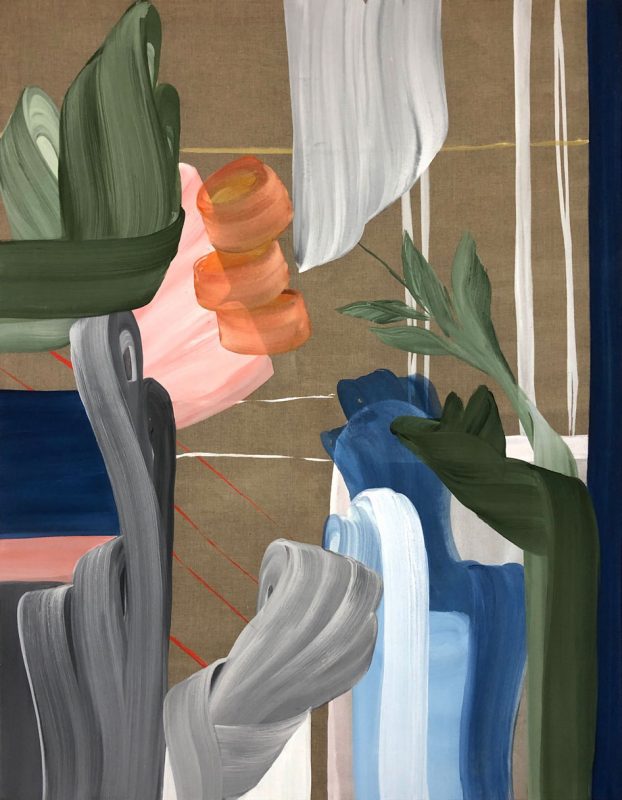
›Each painting is to me a vision, a scene, a view. My interest for the Italian Renaissance, be it technical and theoretical, is infused with the mystical beauty of the visual productions of Ancient Persia. The free gesture inscribes itself through wide ribbons that vary between dark and light colours. The flexibility of the movements and the strokes calls to mind Persian calligraphy. The spectator might sometimes see vegetal, floral, plant forms, which are quite visible in bold floral pattern of early carpet design and other times might see baroque drapery. The spaces are built by the dialectic between opacity and transparency, closeness and distance, putting layers over layers to construct the depth. I would like to tell stories of dreamed landscapes between abstraction and figuration.‹
Bradley Davies (*1990, London, UK)
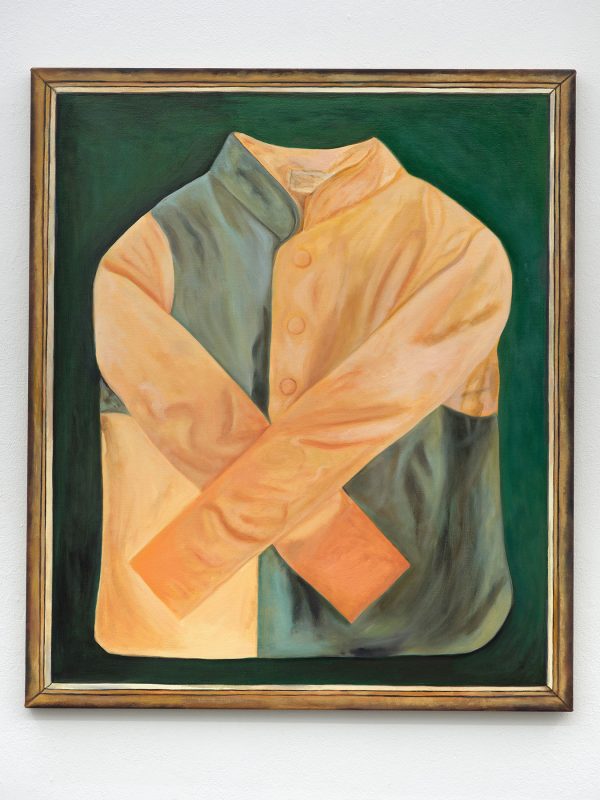
›Over the past decade I have been making work in various media from drawing and painting, sculpture, installation, sound and performance. I’m interested in how we discover ourselves through the society we build with the stories we share, the music and games we play, the routines or rituals we have. Which explains why my work often reflects on the environment it finds for itself. The environments are demanded by the work/exhibition, its place in time and location or a reflection of my experiences – with its mesh of absurd satire and comedy, and love for poetry. I want people to enjoy discovering something for themselves in my work and be able to find a sense of humour and humility with it.‹
Veronika Hilger (*1981, Prien am Chiemsee, Germany)
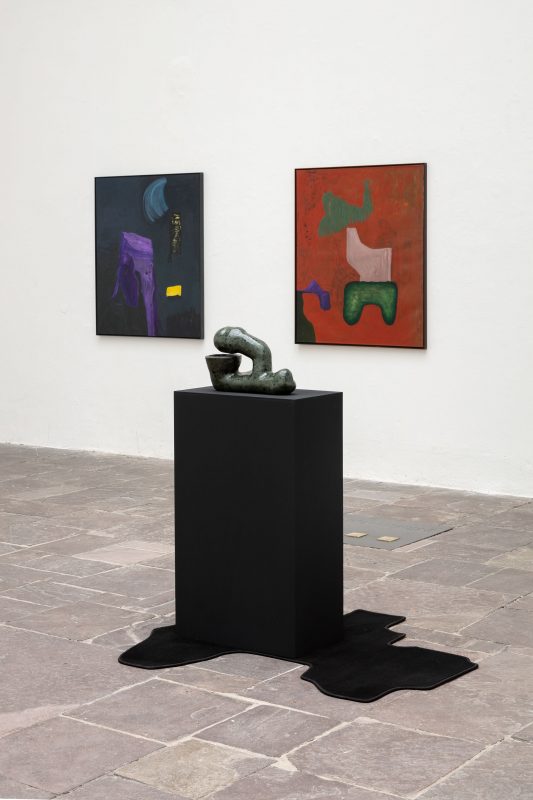
›My paintings and sculptures fuse figurative elements with gestures of painterly expression. The mostly monochrome glazed ceramics thereby expand the visual language of my paintings. The approach in both media is intuitive and emotional, whereby traditional genres of landscape, still life and portrait provide an orientation. Something akin to a vase, thereunder a cartoon-like hand, a yellow glowing ridged form, magical light, something representational?… Where narrative takes second place to signs, gestures, and stereotypes, we depend more overtly on our pictorial memory and experiences. Here, intimate spaces of memories and expectations emerge.‹
Ada van Hoorebeke (*1982, Kortrijk, Belgium)

›Over the last thirteen years, I have immersed myself into painting with wax (Batik) and researched ways to produce my own colours and dyes with natural waste materials. My installations reflect the process of making and function as platforms for exchange and collaboration. Besides the works, tools constitute a vital component. Through workshops, collaborative textile dyeing sessions, photo shoots and performances, I seek to involve viewers in the production processes. This allows a new approach to artistic production provoking a reflection on concepts such as manual labour, production chains, ›female‹ labour and thinking.‹
Anna Slobodnik (*1990, Moscow, Russia)
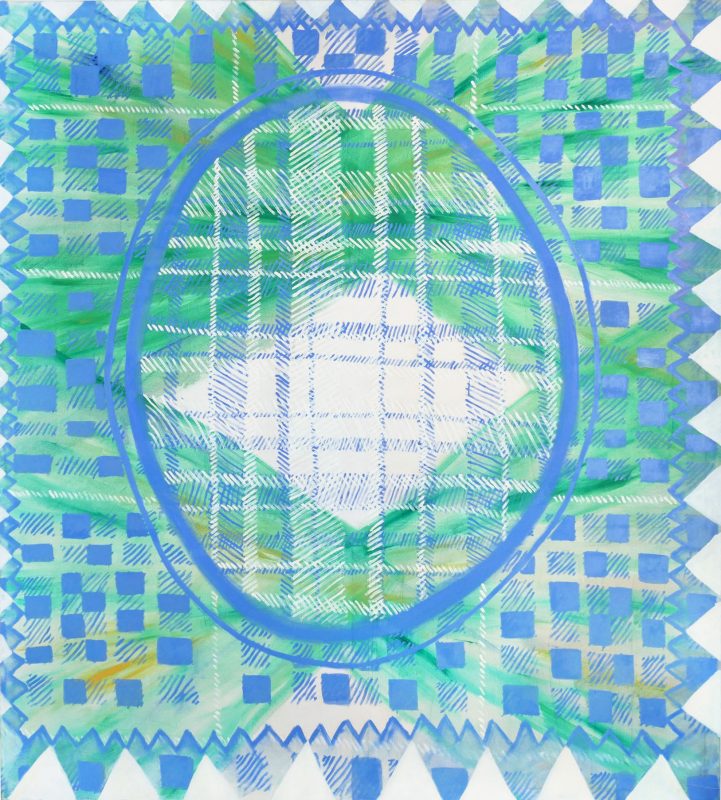
›I engage with patterns. I collect them, work with them and investigate possible breaking points. In addition to the potential of painting, I am interested in the intersections between the alleged ›applied‹ and ›liberal arts‹, as well as the roles they take on. I conceive patterns and ornaments as metaphors, as references to the role of women as producers, and as manifestations of a cultural identity. Being an artist with a migrant background, I am processing a multiplicity of influences. I am interested in the meaning of patterns as signs of recognition (re)producing identity, as in my possibility of transforming them.‹
 Ada van Hoorebeke, ›Rose Family Factory‹, 2021, Ausstellungsansicht: WERK.STOFF Preis für Malerei, Heidelberger Kunstverein, 2021. © Markus Kaesler & HDKV. Courtesy Ada van Hoorebeke
Ada van Hoorebeke, ›Rose Family Factory‹, 2021, Ausstellungsansicht: WERK.STOFF Preis für Malerei, Heidelberger Kunstverein, 2021. © Markus Kaesler & HDKV. Courtesy Ada van Hoorebeke
In response to the extension of the current partial lockdown, ›Wir sind hier – We are here‹ presents works by artists working for the Heidelberger Kunstverein:
Katharina Andes, Matthis Bacht, Maximilian Bauer, Eva Gentner, Manuel Dück, Diana Frasek, Matthias Gmeiner, Rosa-Violetta Grötsch, Valentina Jaffé, Markus Kaesler, Felicitas Kunisch, Eyal Pinkas, Nicolas Reinhart, Malte Römer, Björn Ruppert, Jochen Steinmetz, André Wischnewski
It is their labour that facilitates the realization of the Heidelberger Kunstverein’s exhibitions and associated programming.
As experts for artistic production, they are regularly involved in installing and deinstalling shows, exhibition documentation, art education and mediation at the Heidelberger Kunstverein and other institutions. As most of them are employed for temporary services, the extended closure of exhibition spaces effects them existentially. They do not only lose the opportunity of presenting their art, but also a substantial part of their income.
Now it is time to dedicate the exhibition ›Wir sind hier – We are here‹ to our employees – as always we pay artists’ fees.
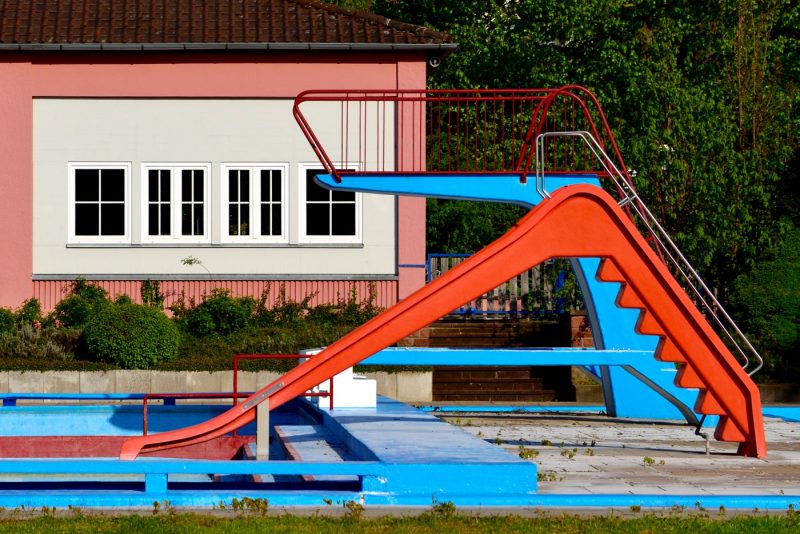 Jochen Steinmetz, ›LOCKDOWN 2020 - Billboard Exhibition‹, 2020, PVC-Gewebe-Banner, LKW-Plane, 355 x 255cm, © Jochen Steinmetz
Jochen Steinmetz, ›LOCKDOWN 2020 - Billboard Exhibition‹, 2020, PVC-Gewebe-Banner, LKW-Plane, 355 x 255cm, © Jochen Steinmetz
Film installations in cooperation with the 69th International Filmfestival Mannheim Heidelberg (IFFMH)
planned duration: 12.11. 2020 – 17.1.2021.
Until 31.12.20 the Heidelberger Kunstverein will remain closed due to measures to contain the coronavirus.
Film contributions are included in our daily changing film program online.
Our partner, the IFFMH, is streaming the films as part of the section ›Facing New Challenges‹ on their platform. They are available to rent until the 22. of November.
Ursula Biemann, Sky Hopinka, Karrabing Film Collective, Tuomas A. Laitinen, Sonia Levy, Nina E. Schönefeld, Tabita Rezaire, Susanne M. Winterling
With the exhibition ›Facing New Challenges‹, the 69th International Film Festival Mannheim Heidelberg (IFFMH) 2020 presents a new format in cooperation with the Heidelberger Kunstverein (HDKV). Cinematic works by international visual artists – on show as permanent installations beyond the duration of the festival – enter into a dialogue with narrative cinema and hence broaden the perspectives of moving image production.
As the inaugural exhibition in an ongoing series, ›Facing New Challenges: Water‹ brings together international contemporary artistic works concerned with ›water‹. In view of climate change, current and expected distribution struggles, and in relation to (post–)colonial history, ›water‹ remains a crucial issue of our times. It is a symbol of the current ecological crisis, the scene of various geopolitical and ethnopolitical struggles, and, as a commodity, an object of exploitation. As the largest of all ecosystems, water also functions as a fascinating habitat for a community of organisms that perform vital environmental functions. In the selected films, water appears as an object of (scientific) investigation, as a biosphere, as well as a spiritual point of reference. As diverse as this range appears as varied are the filmic practices brought together by the exhibition.
 Tuomas A. Laitinen, ›Haemocyanin‹ (still), 2019, Courtesy Tuomas A. Laitinen / Helsinki Contemporary
Tuomas A. Laitinen, ›Haemocyanin‹ (still), 2019, Courtesy Tuomas A. Laitinen / Helsinki Contemporary
Discarded Plexiglas panes from bus stops lie over delicate watercolours. Images made up of several layers exhibit traces left by unknown passengers. Architectural models find their place on the floor; pneumatic objects sway in space. Ian Kiaer’s poetic installations of everyday objects, found materials, models and painting can be experienced as open arrangements.
With his ›endnotes‹ the internationally renowned British artist suggests references to (utopian) designs from architecture, philosophy and literature. The starting point for his works are, for example, Friedrich Kiesler’s examination of endless space, Michael Marder’s investigations into the experience of plants, Samuel Beckett’s text experiments or the experiments with inflatable architecture in the late 1960s.
His installations and objects can be understood as an open experimental set–up or as the (preliminary) result of a series of associations. In this way, he creates spaces of experience that simultaneously open up spaces of thought: historical impulses and current debates are brought together to negotiate one’s own position in relation to the world.
The title of the exhibition ›endnote (ping)‹ refers to Samuel Beckett’s short story of the same name ›Ping‹, original ›Bing‹, from 1966. The text – barely 1000 words in length – forms a hypnotic flow of words:
›All known all white bare white body fixed one yard legs joined like sewn. Light heat white floor one square yard never seen. White walls one yard by two white ceiling one square yard never seen. Bare white body fixed only (…)‹
As a reader, it is difficult to orientate oneself – the language appears too dissected, too reduced. Through repetition and ellipses, Beckett slowly dissolves the distinction between body and space. His departure from linear narration requires a different way of approaching the text. Similarly, Ian Kiaer’s works call for a spatial reorientation, for a kind of spatial awareness that thinks sense and sensibility, thought and experience together.
Ian Kiaer’s ›endnotes‹ do not attempt to illustrate non–utopian, dystopian or revolutionary ideas, concepts and the realities they create. Rather, the artist constellates the various objects and elements to each other, confronting them with different aspects to create a space for associations to be re–thought and further developed.
In cooperation with Kunsthalle Lingen
Ian Kiaer (* 1971, London) studied at the Royal College of Art and Slade School of Art in London and now works in London and Oxford. Solo Exhibitions: Aspen Art Museum (USA), Kunstverein München, Galleria d’Arte Moderna e Contemporanea, Turin and Musée d’Art Moderne de la Ville de Paris. Group exhibitions: Mudam Luxembourg, Tate Modern und Tate Britain in London, Hammer Museum in Los Angeles, Hayward Gallery in London, Manifesta 3 in Ljubljana, Biennale d’Art contemporain, Rennes, Biennale de Lyon, Istanbul Biennale, Venedig Biennale and Berlin Biennale.
 Ian Kiaer, ›Endnote, ping, Marder (pale)‹, 2020, ›endnote (ping)‹, 2020, Ausstellungsansicht,
Heidelberger Kunstverein, 2020 © Heidelberger Kunstverein / Wolfgang Günzel
Ian Kiaer, ›Endnote, ping, Marder (pale)‹, 2020, ›endnote (ping)‹, 2020, Ausstellungsansicht,
Heidelberger Kunstverein, 2020 © Heidelberger Kunstverein / Wolfgang Günzel
Nadira Husain, Amina Ahmed, Varunika Saraf: ›Confluence Sangam संगम‹
as part of the WERK.STOFF Award for Painting of the Andreas Felger Cultural Foundation and the Heidelberger Kunstverein
The words Confluence, Sangam / संगम describe, in English, French and Hindi, the moment when several currents from different directions meet, flow into each other, and find their way together.
The pictorial works of Nadira Husain, laureate of the WERK.STOFF Award, express such a confluence of different cultural visual worlds. Daughter to an Indian father and a French mother, she draws from her own life experiences when Islamic art and cultural history of the Indian subcontinent meet globalized pop-cultural references in her colourful works. Hybrid bodies inhabit Husain’s canvases and textile surfaces: Comic figures meet Mughal miniatures, Indian divinities and mythological creatures. By employing traditional handicraft techniques – some of which she carries out in cooperation with various artisans – she creates transcultural visual worlds of the 21st century.
›Confluence Sangam संगम‹ extends the exhibition of the laureate by two positions: Amina Ahmed and Varunika Saraf will both present their works in Germany for the first time. They share their Indian roots and experiences of migration that shape their way of working and thinking. Varunika Saraf (Hyderabad) uses the technique of miniature painting to capture current protest movements in India. Amina Ahmed (New York) finds her basic geometric forms and patterns in the so-called folklore of different cultures that have shaped her life.
The works of the three artists are signs of appropriation and cultural contact in global contexts. Through the migration processes that are firmly embedded in their stories, they actively engage in the shaping of transcultural heritage.
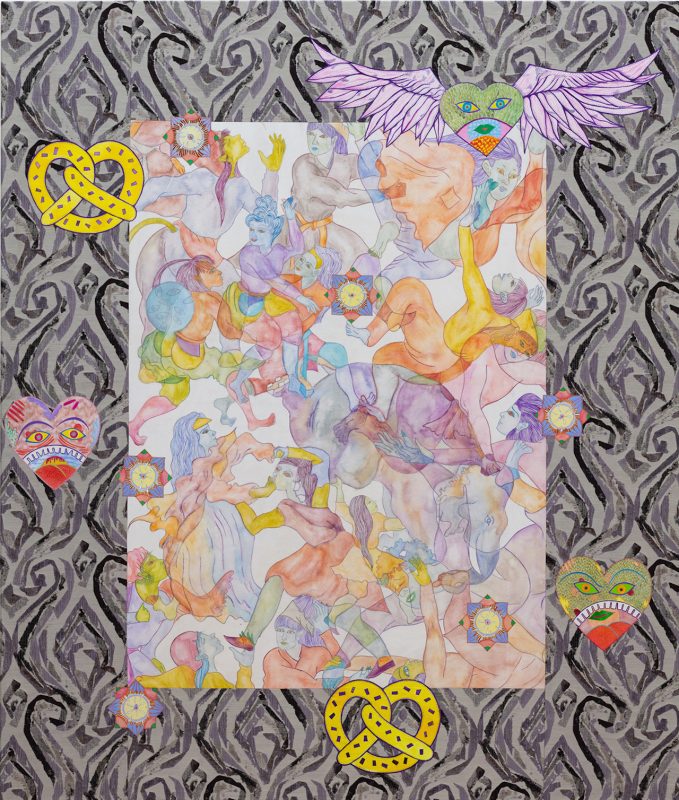 Nadira Husain: ›Somewhere Between Love and Fighting, silber‹, 200 x 170 cm, 2020, Aquarell und Acryl auf Leinwand und Textil, © Nadira Husain und Tobias Naehring
Nadira Husain: ›Somewhere Between Love and Fighting, silber‹, 200 x 170 cm, 2020, Aquarell und Acryl auf Leinwand und Textil, © Nadira Husain und Tobias Naehring
Re-Opening on Wednesday, 5/6
We are happy to reopen and looking forward to welcome you at the HDKV
The measurements due the Covid 19 Pandemie apply for the visit at the HDKV
in short:
Obligation to wear a mask
Keeping Distance about 1,5 meters
Reglementation of numbers of visitors
Opening in Heidelberger Kunstverein: Sunday, 1.3.2020, 11 p.m.
followed by a guided tour with David Company (curator) and Sebastian Riemer (artist)
The British expert photographer and curator David Campany was chosen for his famous and new talents to curate the photography event of the year: the Biennale für aktuelle Fotografie 2020. Six exhibition houses in the metropolitan area are involved. The Heidelberg Kunstverein presents works by international stars such as Thomas Ruff, Sebastian Riemer and Clare Strand under the title ›Yesterday’s News Today‹.
One of the primary tasks of the twenty-first century has been to make sense of the twentieth: to pick over its bones and discover small indications of what we have become. We sift that »pile of fragments of private images, against the creased background of massacres and coronations«, that the writer Italo Calvino concluded was »true, total photography«.
Over the last decade, hundreds of thousands of old news photographs, mostly 8×10 inch black and white prints, have been dumped for online sale. As newspapers struggle to survive, the old photographs in their archives are the first casualties. Most sell for just a few dollars to whoever might want them. Whatever their fate, this photographic material is finding itself in new contexts, to be re-thought by artists, acquired by collectors, examined by historians, and exhibited by curators.
The current interest shown by artists in old news images is hybrid, somewhere between media archeology, history and image making. The old photos are reworked but also represented so we can see them, or encounter them again, in their strange new settings. What results is a sort of multi-temporality, in which the image is seen for what it was, for what it now is for the artist and viewer, and for what it could become in the future.
During the exhibition ›Yesterday’s News Today‹ , the Biennale opens its doors to the press archives of the Rhein-Neckar region. In the archives analogic prints from the 1950s-1990s are shown. On the print’s front and back, visitors can find traces of editing, retouching, cutting as well as notes from editors, images editors, journalists and photographs. The archives do not only focus on the region visual memory, but also recognize the use of images as an important and influential instrument to shape our perceptions of local and international events.
Technoscapes
Art and technology
New technologies determine our everyday life and are sometimes discussed controversially. With the group exhibition “Technoscapes” – curated by Ursula Schöndeling – the Heidelberger Kunstverein presents for the first-time artists who are confronted with the use of technology.
The term technoscapes was forged by Indian ethnologist Arjun Appadurai (*1949). His cultural globalization anthropological theory divides itself in five different dimensions. According to Appadurai these have their own rules and constraints, therefore they need to be individually considered in order to explain the modern world. One of these dimensions is the so-called “Technoscape”, that describes the diffusion and access to technologies on a global scale. The term “Technoscapes” is also used for the exhibition to reflect the coexistence of various technological spaces.
The exhibition presents installations, which form a constellation of works that investigate different areas of the technology.
These range from Valeria Abendroth’s fictional medical panoptikum to the picturesque poetic installation of Delia Jürgens, who works with digitally liquified image data sets to Shawn Maximo’s digital representations of future worlds’dystopian architectural designs, in the form of CGIs (computer generated images) to the works of the artists duo FLAME.
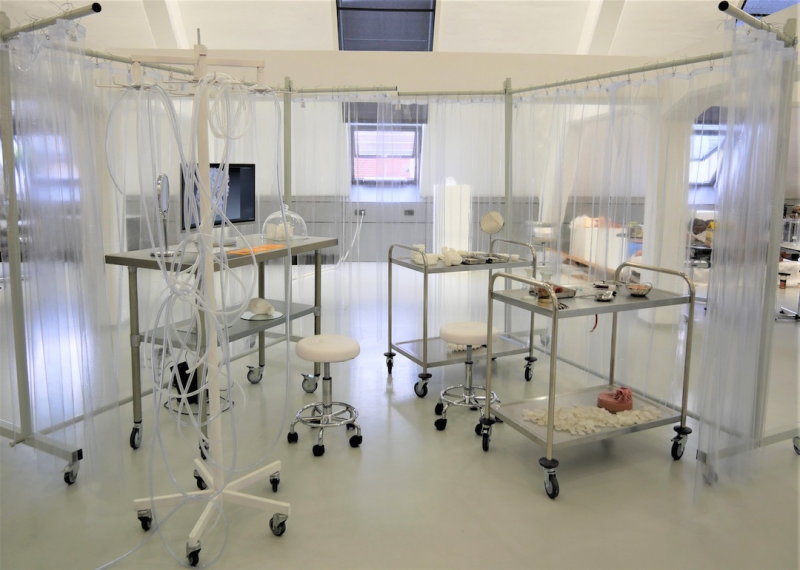 Valeria Abendroth: ›Laboratorium suggerere‹, Installation shot HDKV, Heidelberg 2019, courtesy: Valeria Abendroth
Valeria Abendroth: ›Laboratorium suggerere‹, Installation shot HDKV, Heidelberg 2019, courtesy: Valeria Abendroth
With works by Franz Ackermann, Nelly Agassi, Horst Antes, Kenijro Azuma, Susanne Bauernschmitt, Wilfried Bausch, Gerlinde Beck, Joseph Beuys, Walter Boeckh, Iris Bouwmeester, Sanvja Bühler, Captain Beefheart, Claude Champy, Christo, Natalie Czech, Ivan de Menis, Erwin Degen, Franziska Degendorfer, Simone Demandt, Bea Emsbach, Andrea Esswein, Menno Fahl, Hans Fähnle, Matthias Feldmann, Waldemar Flaig, Seiichi Furuya, Herbert Galle, Rosa Susanne Gärtner, Angela Gelbarth, Johannes Georg Geyger, Hedwig Goller, HAP Grieshaber, Hyun Gyoung Kim, Joe Hackbarth, Stefan Häfner, Jim Harris, Konrad Henker, Christel Hermann, Georg Hildebrandt, Amei Hoffmann, William Hogarth, Hubi M., Alicia Ibarra, Werner Jahn, Armand Jamar, Fritz Jarchov, Tina Juretzek, Gabi Kaiser, Sven Kalb, Horst Egon Kalinowski, Cholud Kassem, Paul M. Kästner, Nishikawa Katsuhito, Martha Katzer, Heinrich Kirchner, Sarah Kirsch, Dirk Klomann, Bernd Knaute, Daniela Kneip Velescu, Christian Köster, Norbert Kricke, Susanne Kriemann, Harald Kröner, Johann-Friedrich Langbein, Max Laurent, Fabian Lehnert, Markus Lüpertz, Matthias Maaß, Igor Maier, Antje Majewski, Halil Kacemer, Jürgen Krause, Krzysztof Marciniak, Philine Maurus, Ludwig Meidner, Luis Valencia Mendoza, Reinhold Metz, Walter Meyer-Vax, Jan Misiek, Jürgen Möbius, Max Neumann, Ulrich Nitschke, Stefan Njavro, Günter Nosch, Marius Ohl, Eva Ohlow, Roswitha Josefine Pape, Georg Karl Pfahler, Eyal Pinkas, Charles Pittner, Sigmar Polke, Hans Reiser, Vera Röhm, Heike Ruschmeyer, SAGA, Maja Sandberg, Renate Sandig, Caspar Sänger, Peter Schlör, Lasse Schmidt Hansen, Johannes Schreiter, Rainer Selg, Martina Spreng, Klaus Staeck, Simon Starling, Antoni Starowieyski, Jutta Steudle, John Stezaker, Ceija Stojka, Maria Tackmann, Yumiko Tanno, Heinrich Tessmer, Karl-Heinz Treiber, Günther Uecker, Christine Ulbrich-Stoy, Claudia Urlaß, Gerhard Vormwald , Ekkehard Vree, Andreas Wagner, Andy Warhol, Gabriele Wilpers, Martin Wollmer, Zhou Brothers
Loans by the members: AAg Architekten – Sammlung Tankturm / (Kai Ring, Stefan Loebner, Armin Schäfer, Stephan Weber), Christian Adam, Marianna Aggelidakis, Michael Akselrad, Erika Albert, Dr. Nicolas Albrecht-Bindseil, Selini Andres, Siegfried Arno Gottlieb Angermüller (SAGA), Dr. Hans Assmus, Barbara Auer, Michael Bacht, Eckard Bannek, Yvonne Bannek, Susanne Bauernschmitt, Sebastian Baumgärtel / Volksbank Heidelberg, Prof. Dr. Britta und Prof. Dr. Dr. Niels Bergemann, Gabi und Malte Berndt, Uta Blänsdorf-Zahner, Arvid Boecker, Stefanie Boos, Daniel Böckmann, Christian Buck, Philine und Albertus Bujard, Claus Bunte, Sibylle Burrer, Hendrik Bündge, Eckart Conze, Ursula Diebel, Angelika Dirscherl, Ingrid Eckert, Carolin Ellwanger, FALK GmbH & Co KG, Susanne Figge, Reiner und Jutta Förster, Beate Frauenschuh, Dr. Gisela Frommer, Matthias Fuhrmann, Erika und Karl-Otto Gärtner, Dr. Rolf-Ludwig Gärtner, Lisbeth Geisel, Hans Gercke, Rosemarie Gercke, Heidi und Dr. Jochen Goetze, Janet Grau, Gisela Hachmann-Ruch, Nadine Hahn, Prof. Dr. Rudolf Hauber, Volker Hällfritzsch, Marianne Heller, Dr. Inge Herold, Harald Hertel, Karin Heyl, Julia Hildenbrand, Prof. Dr. Ulrich Hilgenfeldt, Kristina Hoge, Stefan Hohenadl, Johan Holten, Dr. Herbert Jung, Dr. Susanne Kaeppele, Cholud Kassem, Paul M. Kästner, Ella Kehrer, Olivier Keimel, Gülay Keskin, Stefanie Kleinsorge, Inge Klinger, Nina und Dr. Ansgar Komp, Karin Kopka-Musch, Angelika Krohn, Laura Kuch, Barbara Kunzendorf-Hohenadl, Dr. Sigrid Kupsch-Losereit, Johann-Friedrich Langbein, Mario Lehmann, Bara Lehmann-Schulz, Prof. Dr. Sabine Leipolz-Angermüller, Klaus Lothholz, Dr. Claudia Ludy, Dr. Wilfried Maag, Dr. Frieder Maier-Metz, Ilona Martini, Dr. Doris Marx, Steffen Maurer, Jasmin Meinold, Lilly und Jürgen Neidinger, Dr. Luitgard Nipp-Stolzenburg, Marius Ohl, Birthe Ostendorff, Hans Jürgen Ott, Roswitha Josefine Pape, Julia Philippi, Dr. Andreas Pingel, Eyal Pinkas, Jürgen Popig, Isotta und Dieter Quast, Verena Reichert, Wolfgang Sautermeister, Moritz Sänger, Dr. Dorit Schäfer, Prof. Dr. Marcus Schiltenwolf, Dr. Hildgund Schmidt, Christiane Schmidt-Sielaff, Brigitte Schoch-Joswig, Lynn Schoene, Ursula Schöndeling, Edith und Peter Schramm, Jo Schulte-Frohlinde, Karola Schwarz, Hartmuth Schweizer, Susanne Seitz, Michael Simon, Marta Sobczyk, Klaus Staeck, Rolf Staeck, Christiane und Volker Stich, Dr. Manfred Stolzenburg, Prof. Dr. Manfred Stöhrer, Rainer Teßmann, Friederike und Friedrich Tomi, Andrzej Urbanski, Claudia Urlaß, Mario Urlaß, Yvonne Vogel, Marisa Vola, Dr. Lida von Mengden, Susanne Weiß, Prof. Dr. Rainer Wild, Dr. Beate Wolf, Helga Wolf, Dr. Erich Michael Zahn, Carl Zillich, Dr. Manuel Zink
coming soon
Sharing as Caring no.6
trans-Affects: Stories, Life and Landscapes
Contemporary modes of being and thinking are currently facing strong challenges from the perspectives of multiple disciplines. Confronting these disciplines’ limitations in modern discourses, the recently forwarded notion of the “care” has gained a foothold within interdisciplinary thinking and has become a magnet for revisions of existing discourses. Taking the Fukushima nuclear catastrophe as its starting point, Sharing as Caring was initiated as a series of annual exhibitions destined to addresses the notion of “care” in order to reflect on current conditions of the nuclear presence in contemporary societies. It seeks a form for the intimate link between the political, economic, psychological, and personal desires to deal with the social issues around that nuclear presence.
After living seven years with the aftermath of the Fukushima catastrophe, the current situation in Japan and its neighbouring countries indicates the necessity of a long-term perspective. Here, the name, Fukushima serves only as a cipher to reflect our life style based on nuclear circulations and questions the modernistic relations between human beings, nature and technology that are deeply inherited in our everyday lives. Sharing as Caring no.6, the first instalment in a new series, presents artworks dealing with affects and landscapes behind the nuclear presence. Into Eternity (2010) is a documentary film by Michael Madsen, who is based in Copenhagen, Denmark. The film addresses stories that have been circulating on the construction of the Onkalo nuclear waste repository in Finland. The repository was designed to be located 4,000 km underground to store high-level radioactive waste for 100,000 years, even though in recorded history, no structure made by human beings has ever sustained for such a long time. The film explores ethical questions around the construction vis-à-vis the reality of energy needs and our responsibilities towards the future. A series of photographs, Paradigm (2016) by Satoko Nema, ponders how our bodies cope with the environment that is constantly affected by information technologies and ecological challenges. Instead of being occupied by the baroque of the processed information provided by technological means, the artist, who lives in the southern island of Okinawa, Japan, reconsiders the in/adequacy of human perception in networked societies and urges us to seek ways to synchronise acts of “seeing” with our bodily sensitivities in order to understand our daily environment on a deeper level. Nguyen Trinh Thi is a Hanoi-based independent filmmaker and video/media artist. In her 35mm slide installation, Landscape Series no.1 (2013), the artist presents a collection of 77 photographs, in which people each point out one part of a landscape. It is unclear for the viewer what exactly they indicate; however, this lack of clarity provokes our imagination and guides us to reflect the unsolved issues of a nuclear presence that has lasted over a century. The artist made this work while thinking over the Fukushima catastrophe and pondering the decision of the Vietnamese Government to build the first nuclear power plant in Ninh Thuan Province, in the southern part of the country, in collaboration with the Russian State company Atomstroyexport. In November 2016, the Vietnamese National Assembly abandoned plans for this first nuclear power plant.
The exhibition activates the imaginaries that are embedded in, evolved by and intervening with the art works to demand from us the development of new ways of confronting the nuclear issues on a fundamental level.
Sharing as Caring no. 6: trans-Affects: Stories, Life and Landscapes will be presented from November 30, 2018 to February 17, 2019 at Heidelberger Kunstverein. The series started as curatorial project by Miya Yoshida under the directorship of Susanne Weise at the Kunstverein in 2012; from 2018, it is continued by new Kunstverein director Ursula Schöndeling as a second series.
With the support of Japan Foundation and Danish Arts Foundation
Learn more about the exhibition project in this video by Dr. Miya Yoshida.
An exhibition by Kerstin Stoll in conversation with works by Frederick Kiesler.
In collaboration with the Austrian Frederick and Lillian Kiesler Private Foundation, Vienna.
Opening: 30. November // 7 pm
WERK.STOFF Painting Award of the Andreas Felger Kulturstiftung and the Heidelberger Kunstverein.
The Heidelberger Kunstverein (HDKV) and the Andreas Felger Kulturstiftung (AFKS) are happy to present the results of their cooperation for the WERK.STOFF painting award.
Every three years, the WERK.STOFF painting award rewards artists in the field of painting. It is open to all artists living in Germany who aren’t yet know to the general public and without any age restriction. Artists will be appointed by nominators from the field of art. The prize should allow the winner to focus on his artistic development during an intensive phase of work.
The first exhibition of the five artists nominated for the award will take place in September 2018 at Heidelberger Kunstverein. The selected artists are: Ernst Friedrich Drewes, Friedhelm Falke, Yorjander Capetillo Hernández, Nadira Husain und Michael Thümmricht. The jury – composed of Dr. Martin Engler (Director of the Contemporary Art Collection at the Städel Museum Frankfurt a. M.), Dr. Ulrike Groos (Director of the Kunstmuseum Stuttgart) and Ursula Schöndeling (Director of the Heidelberger Kunstverein) – will select the winner of the award. The winner will present his work in a monographic exhibition accompanied by a publication in 2020.
Concept:
The WERKSTOFF art award understands the concept “Painting” in a broad sense. The works can encompass the traditional combination of brush, oil and canvas but can also reach into the room and space, as well as break traditional conventions. The award aims to put the diversity of painting at the center of the public perception.
Course:
1. Conception of an exhibition of the five selected artists (Autumn 2018).
2. Designation of the winner and awarding of the prize money of 10.000 euros. The decision of the jury is non-disputable, recourse to legal action will not be possible.
3. Conception of a monographic exhibition and publication of the awarded artist (2020).
The nominees are:
Ernst Friedrich Drewes (nominated by Dr. Dieter Scholz)
Friedhelm Falke (nominated by Dr. Danièle Perrier)
Yorjander Capetillo Hernández (nominated by Prof. Jean-Baptiste Joly)
Nadira Husain (nominated by Prof. Antje Majewsky)
Michael Thümmrich (nominated by AFKS)
Jury 2018:
Dr. Martin Engler (Director of the Contemporary Art Collection at the Städel Museum Frankfurt a.M.)
Dr. Ulrike Groos (Director of the Kunstmuseum Stuttgart)
Ursula Schöndeling (Director of the Heidelberger Kunstverein)
The vernissage of the nominees’ exhibition will take place on September the 9th, 2018 at 19:00 (7:00 p.m) at the Heidelberger Kunstverein.
The jury will distribute the award during the closing ceremony of the exhibition at the Heidelberger Kunstverein on November the 11th, 2018.
2019 will mark 150 years of the Heidelberger Kunstverein. In occaison of that we want to retell the story of the Kunstverein and its members but to do so we need your contribution!
The second edition of the history workshop at the Kunstverein’s studio presents three past exhibitions, with which the Kunstverein has contributed to important social debates of the time and which were discussed in Heidelberg partly controversial: The first extensive and psychiatric critical exhibition of the historical collection Prinzhorn (1980) as well as the presentation of the estate of the photographers Gottmann sen. and jun. (1980), which gave rise to an argument with the controversial urban renewal. With the project ›ISLANDS+GHETTOS‹(2008), the Kunstverein discussed the global phenomenon of territorial segregation of 21st century cities in a comprehensive program.
We are calling out all members, fellows and friends to share their memories through text, image or words. Maybe you own interesting personal photographs from our events and exhibitions? Bring them along! Or perhaps you witnessed a particularly special occasion at the Kunstverein? Tell us about it! We look forward to finding out about your impressions and ideas.
Dates:
18.9. with Dr. Friedrich Kasten
25.9. with Hans Gercke
9.10. with Johan Holten
23.10. with Dr. Bettina Brand-Claussen and Doris Noell-Rumpeltes
6.11. with Francis Kelly
Film Screnning
4.10. with Nicole Güther and Jasmin Meinold
Meisterschüler of the State Academy of Fine Arts Karlsruhe
Exhibition opening : Sunday, 22nd of July, 11 a.m.
The 23 current ›Meisterschüler‹ – master students – of the National Academy of Fine Arts Karlsruhe are from July 22nd to August 19th guests of the Heidelberger Kunstverein with their exhibition ›TOP_0018‹. The graduates from different classes will give a comprehensive insight into their current work while they transition from higher education to professional artistic independence. The diversity of the works – which includes all forms of expression in the fields of painting, sculpture, drawing and graphics, but also video art and performance – highlights the varied possibilities of contemporary art.
The name ›Meisterschüler‹ or ›master students‹ is a specific term that designate chosen students of the Academy. This title is exclusively granted by their professor. Master students are allowed to study one more year at the Academy ; they are attributed a workshop space and can enjoy all the benefits linked to the trust of their professor and the access to the varied infrastructures
The artists are : Johannes Bierlein, Lorenz Bögle, Stephanie Deuter, Vivian Eckstein, Desirée Eppele, Jorinde Fischer, Tatjana Gaer, Helene Kadura, Jimmy Langer, Maximilian Lanzl, Jannis Müller-Jehle, Martin Pöll, Bo Youn Ryu, Clarissa Schnitzer, Anna Schütten, Sebastian Späth, Nathalie und Alexander Suvorov-Franz, Thomas Henning, Hailin Wang, Johanna Weber, Nils Weiligmann, Jan Zöller.
Exhibition coordination: Prof. Kalin Lindena, National Academy of Fine Arts Karlsruhe
The city is booming: More than 60 percent of the world’s population live now in cities – and the number is rising. From the very beginning, artists have taken on the theme of the city, whether as an utopian blueprint for a way of creating better communities or as a reflection of the actual conditions of life. The international group exhibition ›Stadtansichten‹ (›Cityscapes‹) embraces the discussion around the ideas of the city, with modern views and the measurement of real living and working conditions and presents international examples over the last 60 years.
At the same time, the neighboring Kurpfälzisches Museum presents depictions of Heidelberg from the end of the Middle Ages to the 21st century.
Associated with IBA Heidelberg 2018
Opening together with Kurpfälzisches Museum: Saturday May 5. // 3pm.
Under the direction of the artist Janet Grau, professionals and non-artists worked together to encourage participating refugees finding a way to express their hopes and desires. Beginning with their experience of fleeing their countries and the complicated situation they faced when they arrived in Germany, they created artworks which represent real experiences as well as desired outcomes. These “Wunschbilder” (desired images, ideals) mark one possible path and recognize the power of fiction as a culturally significant technique.
Blog: https://wunschbilder.wordpress.com
The staged scenes were directed by Mohamad Alraghban (Damascus) and Taisir Al Nakib (Mosul). The photographer Ella Kehrer supported the project.
Funding was provided by the state of Baden-Württemberg’s Innovationsfonds Kunst and the city of Heidelberg’s Kulturamt.
Queer Festival Heidelberg at the Heidelberger Kunstverein.
In the anonymity of fast growing cities in the 20th century homosexuals created their own spaces, the so-called ›gay ghettos‹. These ghettos run since the 50s businesses and institutions targeted at homosexuals. To a great extent, these areas still offer the freedom of unsanctioned self-expression, whereas every other urban space needs to be first checked for ‘homo-compatibility’.
The Queer (sub) cultures, that emerge in these cities, profile a counter-public which develope specific communication codes and norms. These include the use of certain symbols, behaviours as well as fashion. Florian Glaubitz and Robin Kirchner capture all of this in their photo series ›Crossing‹ and explore the relationship between physicality and their materiality.
In the exhibition ‘Protocols’, visitors were able to familiarize with a series of model designs of the houses by Jean-Pascal Flavien. The artist devises and constructs fantastical houses, that interrogate and expand popular ideas about the role and use of architecture.
His constructions don’t comply with any building norms, instead turning them on their head. He is interested in states of being, feelings and dreams, as well as surprising situations and actions that are called forth by his buildings. Literary quotes and narratives are woven into his designs as fictional elements.
So far, Flavien has been able to realise eight houses out of the extensive collection of his designs, which were exhibited in an exterior space. In 2018, we will have the opportunity to erect the ‘house with things behind’ from the ‘short story houses’ series in the hall of the Heidelberger Kunstverein. A house that, through its open structure – it does not envisage a roof or back wall – investigates the limits between sculpture, architecture and installation, particularly between the work and the exhibition space.
As with all models of the ‘short story houses’, the ‘house with things behind’ also includes a short story by the artist. The stories deal with coexistence, and the dialogue between friends, couples or different living beings amongst other things. It also speaks of cohabitation or the neighbourly ignorance of two environments that do not recognise one another at all.
But they are also reflections on his own design work. The texts create poetic main themes for the houses, in which inside and outside, physical and psychic space overlap and are juxtaposed.
The ‘house with things behind’ includes a storage space behind the lightblue facade. This is where raw materials used for cladding and isolation can be found. With minimal gestures, Flavien creates a concentration of the sensual qualities of the materials. Piled next to the brittleness of steel wool are leather scraps and wool fibres. In the middle of this unslaughtered wealth of materials are improvised constructions: a tent made of cotton wool panels serves as a roof over one’s head which the three-sided facade house doesn’t appear to predict. Conversely, there are fenced off exit areas that designate the outside.
In Flavien’s short story, the friends Baku and Alexis live in front and behind the house: one is concerned with maintaining the facade and the outdoor area – revelling in the sky-blue and the sun – whilst the other spends his time sorting out and lending form to the things in storage and behind the house. Both are occupied with the upkeep of the house, which gives each of them a particular function, and divides their movement radius into ‘in front’ and ‘behind’. They interact with the house and are simultaneously actors in the mise-en-scène of the house.
This scenario also reveals itself to the visitors who experience the house from different perspectives. Though a distanced outside view is possible, the fusing of the house with its outside areas, and the exhibition space, involves the viewer in the surrounding composition. In the same way, the fixed categories of inside and outside are shifted. Yet this does not involve spatial expansion alone. Rather, the common ideas surrounding spaces and their functions are up for debate.
The ideas laid out by the model of the ‘house with things behind’ unfold with extensive potential in the hall of the Heidelberger Kunstverein: the house opens up individual experiences on differing levels for each of the visitors. It is a counterpart which demands new exchanges and new perspectives, fostering reflections on constructed environments and living spaces.
Jean-Pascal Flavien’s houses develop during a long process, which is often incited by observation, text, objects, an idea or a feeling. Sketching, text and the model are artistic means for the development of a design and are the preliminary stage to the house, which is inhabited and enacted as a building.
In a series of artist books, Flavien presents these intertwining processes. With progressive development towards the house that is constructed to scale, the aspects of the houses gain shape: details such as clothing and furniture design or the arrangement of the exterior is developed. Finally, the house becomes the setting for various actions. The construction of the house is thus not the culmination, but a highlight in an ongoing process.
We would like to thank the Ministry for Science, Research and Art in Baden-Württemberg (MWK), the Institute Française Germany and the company DBW for their support in the realization of this exhibition.
Jean-Pascal Flavien was born in 1971 in Le Mans, France. He studied Fine Arts in Rennes, Bologna, Lorient, and participated in the Graduate Program of the University of California, Los Angeles. The artist lives and works in Berlin.
Flavien’s recent solo exhibitions include: dancers sleeping inside a building, Les Ateliers de Rennes – Biennale d’Art Contemporain, Musée de la Danse, Rennes (2016); folding house (to be continued), NMNM – Nouveau Musée National de Monaco (2016); folding house, NMNM – Nouveau Musée National de Monaco (2015); statement house (temporary title), RCA, London (2015); night house at daytime, textes de nuit, Angle Art Contemporain, Saint-Paul-Trois-Châteaux (2013); Cinonema, no drama cinema, South London Gallery, London (2012); breathing house, la maison respire, Parc Saint Léger, Centre d’art contemporain, Pougues-les-Eaux (2012); Jean-Pascal Flavien, Kunstverein, Langenhagen (2012), and PLAY, HEDAH/Jan van Eyck Academie, Maastricht (2011).
Recent group exhibitions include: The Way We Perform Now, Ujazdowski Castle – Centre for Contemporary Art, Warsaw (2017); Meeting Points 8, Beirut Art Center, Beirut (2017); Variable Dimensions – Artists and Architecture, MAAT, Lisbon (2017); The House of Dust by Alison Knowles, The James Gallery, New York (2016); Jump, CAC Brétigny – Centre d’Art Contemporain, Brétigny-sur-Orge (2016); L’Esprit du Bauhaus, Musée des Arts décoratifs, Paris (2016); De toi à la surface, Le Plateau – FRAC Ile-de-France, Paris (2016); La collection des objets que l’on utilise sans les toucher, CNEAI, Chatou (2015); All that falls, Palais de Tokyo, Paris (2014); Was Modelle können, Museum für Gegenwartskunst Siegen (2014).
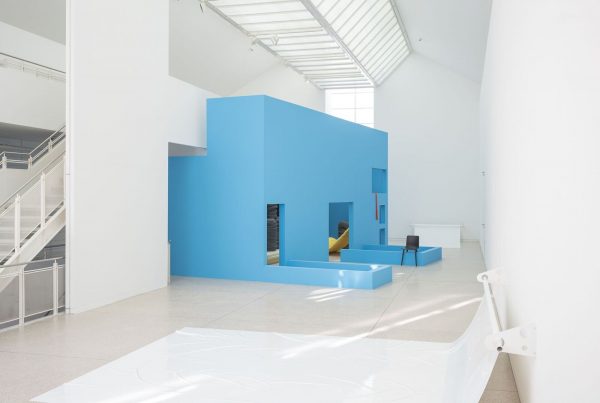 Jean-Pascal Flavien: ›house with things behind‹, with ›floor dispenser‹, Heidelberger Kunstverein, 2018, Photo: © Thilo Ross
Jean-Pascal Flavien: ›house with things behind‹, with ›floor dispenser‹, Heidelberger Kunstverein, 2018, Photo: © Thilo Ross
2019 will mark 150 years of the Heidelberger Kunstverein so we think that’s a good reason enough to celebrate! We want to retell the story of the Kunstverein and its membership but to do so we need your contribution!
We’ve set up a history workshop at the Kunstverein’s studio. With the aid of carefully selected sources we will present the first results of our research. Discover what spaces the Kunstverein has inhabited and what Wilhelm Fraengel and H.W.D had to do with it. What role did Heidelberg and representatives of the Verein play in the ‘art historian debate’ in 1900? What exhibitions contributed to which key social debates? We have a lot of material from the last seven decades but we need further information from you to complete it…
We are calling out all members, fellows and friends to share their memories through text, image or words. Come and view our rich photo archive and help us organise it! Maybe you own interesting personal photographs from our events and exhibitions? Bring them along! Or perhaps you witnessed a particularly special occasion at the Kunstverein? Tell us about it! We look forward to finding out about your impressions and ideas.
Jean-Pascal Flavien’s practice combines elements from architecture, sculpture, and the performative. The artist’s houses are based on imaginary settings imposed by the artist and/or requirements determined by function and imagined site. Each house bespeaks certain circumstances (technical, aesthetic and existential) but in turn may also itself produce such conditions. The structures are conceptual entities, representing ideas, locations, and events in which the architectural conditions can determine the behavior of its inhabitants (and vice versa).
Jean-Pascal Flavien was born in 1971 in Le Mans, France. He studied Fine Arts in Rennes, Bologna, Lorient, and participated in the Graduate Program of the University of California, Los Angeles. The artist lives and works in Berlin.
Flavien’s recent solo exhibitions include: dancers sleeping inside a building, Les Ateliers de Rennes – Biennale d’Art Contemporain, Musée de la Danse, Rennes (2016); folding house (to be continued), NMNM – Nouveau Musée National de Monaco (2016); folding house, NMNM – Nouveau Musée National de Monaco (2015); statement house (temporary title), RCA, London (2015); night house at daytime, textes de nuit, Angle Art Contemporain, Saint-Paul-Trois-Châteaux (2013); Cinonema, no drama cinema, South London Gallery, London (2012); breathing house, la maison respire, Parc Saint Léger, Centre d’art contemporain, Pougues-les-Eaux (2012); Jean-Pascal Flavien, Kunstverein, Langenhagen (2012), and PLAY, HEDAH/Jan van Eyck Academie, Maastricht (2011).
Recent group exhibitions include: The Way We Perform Now, Ujazdowski Castle – Centre for Contemporary Art, Warsaw (2017); Meeting Points 8, Beirut Art Center, Beirut (2017); Variable Dimensions – Artists and Architecture, MAAT, Lisbon (2017); The House of Dust by Alison Knowles, The James Gallery, New York (2016); Jump, CAC Brétigny – Centre d’Art Contemporain, Brétigny-sur-Orge (2016); L’Esprit du Bauhaus, Musée des Arts décoratifs, Paris (2016); De toi à la surface, Le Plateau – FRAC Ile-de-France, Paris (2016); La collection des objets que l’on utilise sans les toucher, CNEAI, Chatou (2015); All that falls, Palais de Tokyo, Paris (2014); Was Modelle können, Museum für Gegenwartskunst Siegen (2014).
The life-sized project folding house (to be continued) was acquired for the collection of the NMNM – Nouveau Musée National de Monaco and inaugurated in July 2016 on the museum’s outside terrace.
 Exhibition view: Jean-Pascal Flavien ›Protocols‹, Heidelberger Kunstverein 2018, Photo: Daniel Schreiber
Exhibition view: Jean-Pascal Flavien ›Protocols‹, Heidelberger Kunstverein 2018, Photo: Daniel Schreiber
Beyond his work related to the Internet, Wolfgang Plöger’s artistic practice includes diverse media like film, photography, sculpture, and diverse printing techniques. All works focus the inherent laws of the specific medium. How does a series of net-based images changes if printed in a book? What happens if a text is printed directly onto the film loop and being projected afterwards? What kind of images are created if single layers of color are separated from a CMYK print? Plöger doesn’t employ media as a container. Instead he generates the subject of the work based upon the medium. More and more, his oeuvre develops into a self-referential system of pictorial and textual information.
The central theme picked out here is the conditioning of both, image and text, the pre-formatting or framing of content which is running like a common thread through the history of media – just think of the book, index cards, photographic plates, substandard film, Polaroid, Cinemascope, computer screen, Twitter, Instagram… The medium still is the message.
Wolfgang Plöger (1971) in Münster, Germany lives and works in Berlin.
Exhibitions: MMK Zollamt, Frankfurt a. M.; westlondonprojects, London; Kreuzberg Pavillon, Berlin; KW – Institute for Contemporary Art, Berlin; Kunstverein Langenhagen; Künstlerhaus Bremen; Kunstverein Schloss Plön.
Erkan’s work is reflective of her interests in cultural and intellectual history in relation to contemporary culture and her use of materials reveals her deep knowledge of 19th and 20th century sculpting. For her presentation at Zona Maco, Erkan has created a series of sculptures related to the use of molybdomancy and ceromancy – methods for fortune telling, used in northern Europe and in the Middle East, where hot, melted lead, tin or wax is poured into cold water and the resulting object is read by a person who can interpret the forms, using a form dictionary for the reading of their meanings. Her handling of materials even just through their sheer volume and weight can appear tough, their industrial origins prosaic, and the robust forms she produces severe, at first glance. Erkan works in the tradition of modern sculpture – creating in all sincerity, but with the awareness that objects are capacitors, magical objects, a solidified mass of memories and desires.
Elif Erkan (b. 1985) lives and works in Los Angeles. She gratuaded at the Städel School, Frankfurt/Main in 2013.
Soloshows: Portikus, Frankfurt (2014); Maison des Arts, Brussels (2015). Groupshows, amongst others: WIELS Centre d’art contemporain (2014); Hamburger Banhof, Berlin (2016); The Glucksman Museum, Cork, Ireland (2016). Grants and Residencies: Villa Aurora Berlin Fellowship (2015); DAAD Travel Grant United States (2014); Fulbright United States Travel Grant Wiels Residency Program, Brussels, Belgium (2013/14).
On occasion of the Biennale für aktuelle Photography ›Farewell Photography‹
More than a hundred fifty years after its invention, photography’s presence in the political sphere is today as contentious as ever. Its unique ability not only to render people and places beyond our immediate experience visible, but also to lend them new meaning, has often placed photography at the heart of political debates. Still images are better retained by memory, and despite theomnipresence of instantaneous “live” video documentation, iconic images—images that circulate extensively whose mark remains etched in our collective memory—are more likely to be still photographs. Since it first emerged, photography has been either heralded for its emancipatory and civic potential—it’s capacity, in the words of nineteenth-century abolitionist Frederick Douglass, to enable “men of all conditions [to] see themselves as others see them”—or derided and criticised as manipulative, crude and objectifying, as a mechanism of control, surveillance, and classification. At the advent of the digital age, the increasing scope, breadth and speed of image dissemination has made the question of navigating their political potential and shortcomings all the more urgent, and the stakes ever higher.
It is such contradictions and tensions that are explored within “Resisting Images”. The exhibition brings together a range of works operating at the frayed edges of documentary practices, and at the front of the politics of representation. As its title suggests, the works in the exhibition address this ambivalence within an image-saturated present, that is: they look at images both as a means of resistance and as a mode of control to resist against, a unique sort of pharmakon, a poison and a remedy.
curated by Boaz Levin
Natalie Czech (* 1976) lives and works in Berlin. Exhibitions i.a. in CRAC Alsace Altkirch, MOMA New York, Palais de Tokyo Paris, Fotomuseum Winterthur, Kunsthalle Vienna, Hamburger Bahnhof Berlin, Kunstverein in Hamburg, Braunschweig, Langenhagen. Works i.a. in the collections of the MOMA New York, Pinakothek der Moderne Munich, Fotomuseum Winterthur.
From 1982 to 1987 Via Lewandowsky (* 1963, Dresden) studied at University of Fine Arts in Dresden. In the period from 1985 to 1989 together with a group of avant-garde artists ›Autoperforationsartisten‹ he organized subversive performances, which circumvented the official art scene of GDR. In 1989 shortly before the Turn Lewandowsky left the GDR and moved to the Western Germany. He often travels and had multiple long-term stays abroad i.a. in New York, in Rome, in Beijing and in Canada. Nowadays he lives in Berlin.
Since 1986, after his short studies, Durs Grünbein (* 1962, Dresden) has been living as a poet, translator and essay writer in Berlin. He was a guest lecturer at the German Department at New York University and at Villa Aurora in Los Angeles. He has received a lot of awards for his works, i.a. the Peter-Huchel-Prize in 1995, the Georg-Büchner-Prize in 1995, the Literaturpreis der Osterfestspiele Salzburg in 2000, the Friedrich Nietzsche-Prize of the State Sachsen-Anhalt in 2004 and the Berliner Literaturpreis in 2006 of the Preußischen Seehandlungverbunden with the Heiner-Müller-Professur in 2006.
The exhibition ›fühle meinen körper sich von meinem körper entfernen‹ and the symposium ›stumble bumble fail fall hurt‹ take their starting point in dealing with the adolescent and current crises of embodiment.
An exhibition of a production e. V. and friends.
David Polzin (*1982, Hennigsdorf, GDR) studied from 2003 to 2008 at Berlin-Weißensee University of Arts under the supervision of the Prof. Eran Schaerf and Prof. Karin Sander, as well as at BEZALEL – Academy of Arts and Design in Jerusalem. In 2009 he was an A student at Berlin-Weißensee University of Arts. His works were exhibited nationally and internationally. His recent individual exhibitions were ›Möbel und Objekte aus der Postimperialen Phase Deutschlands‹ (Galerie Anselm Dreher, Berlin), ›Obst und Gemüse‹ (MMK Zollamt, Frankfurt) and ›Cassette‹ (Galerie Waldburger, Brüssel). In 2010 / 2011 Polzin was a scholarship holder of the Jürgen Ponto Foundation. In 2015 / 2016 he received a scholarship for cultural exchange ›Kulturaustauschstipendium‹ from the State of Berlin, which included a position of a guest professor at Art Center College of Design Pasadena in Los Angeles. In 2015 his work ›Marken Zeichen Signete aus der Postimperialen Phase Deutschlands‹ was published by AKV Berlin.


